GRANGER, GEORGE MOBRAY (1840-1898). Second lieutenant, 139th New York Infantry, Company I; corporal, 8th Regiment, New York State Militia, Company I. Born in New York, he enlisted as a corporal on May 29, 1862, at New York City, and mustered into Company B of the 8th New York State Militia on the same day. His soldier record indicates that he was absent with leave at some point before he mustered out with his company in September 1862, at New York City. He immediately re-enlisted as a second lieutenant on September 6, 1862, at Brooklyn, was commissioned into Company I of the 139th New York Infantry three days later, and was discharged on March 31, 1863.
Civil War Bio Search
The census of 1870 states that he was a mason by trade whose real estate was worth $10,000, and whose personal estate was valued at $2,500. The 1873 and 1880 Brooklyn Directories list Granger as a bookkeeper; the 1880 census specifically indicates that he was a clerk in a fish store. Granger’s Civil War service is confirmed by the 1890 Veterans Schedule. In 1892, he applied for an invalid pension that was granted under certificate 958,716. As per his obituary in the New York Tribune, he was a member of the Royal Arcanum; members were invited to attend his funeral. His last residence was 53 Monroe Street, Brooklyn. He died from cirrhosis of the liver. In 1898, Annie R. Granger Eveland, who is interred with him, applied for and received a widow’s pension, certificate 479,650. Section 103, lot 6981.

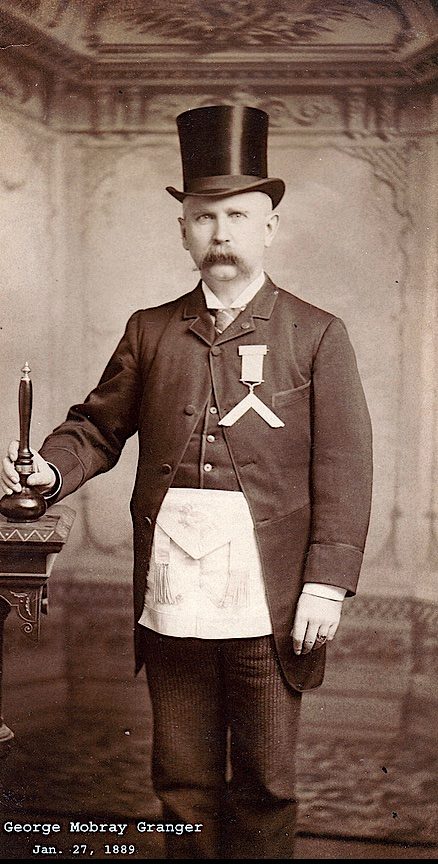
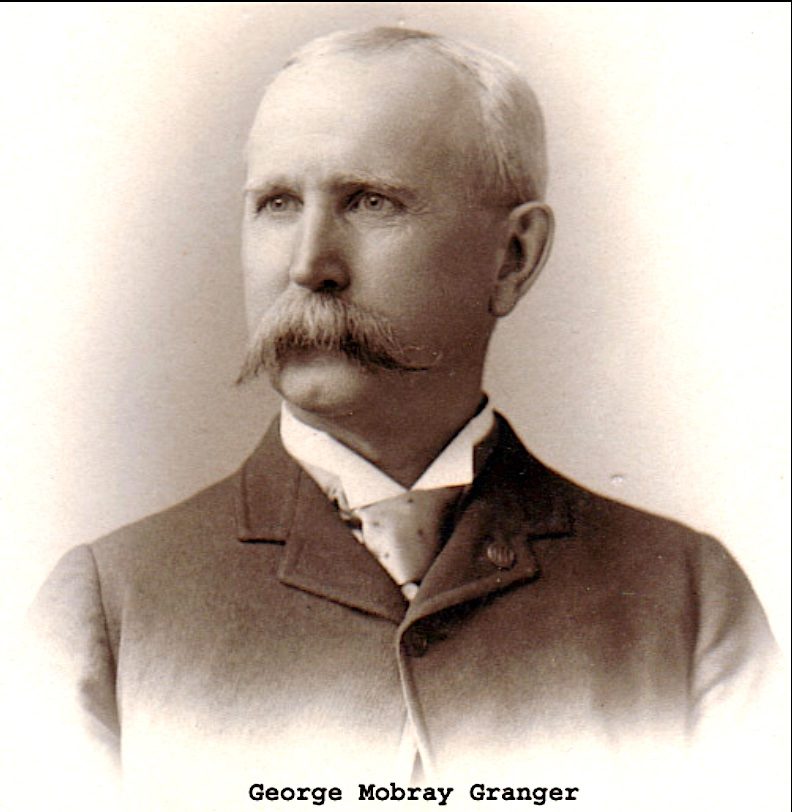
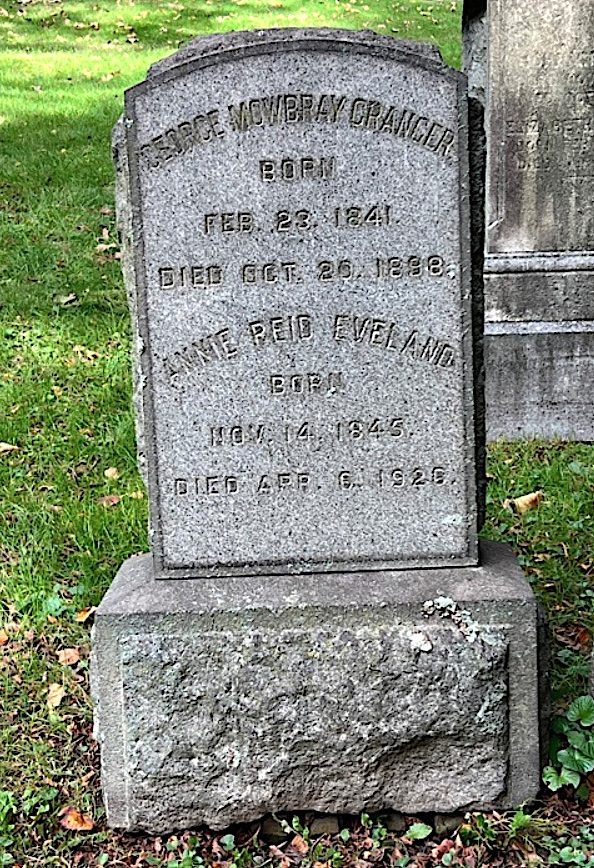
GRANNATT (or GRANNAT, GRANITE), BEEKMAN M. (1840-1905). Corporal, 47th New York Infantry, Company K. He enlisted at New York City on July 9, 1861, and mustered in on September 14. His muster roll indicates that he was also borne on the rolls as Beekman Granite. On an unstated date he was reduced to ranks, and was discharged for disability (“moon blindness”). The 1872 Brooklyn Directory lists him as a turner (wood carver). In 1880, his application for an invalid pension was approved, certificate 267,078. The census of 1900 reports that he was a wood carver. He was known for manufacturing wooden figures used in Punch and Judy shows. Grannatt advertised his wares in the Clipper magazine and was well-known in the industry. (His son, William Beekman Grannatt succeeded his father in the manufacture of the figures in Greenpoint, Brooklyn, at the business established in the early 1900s).
On August 22, 1904, an article in the Brooklyn Standard Union mentions that Grannatt attended a reunion of the 47th Regiment at the New Lexington Hotel. The reunion followed the 38th National Encampment of the G.A.R. at Boston. As per his obituary in the New York Press, which confirms his Civil War service, he belonged to John A. B. Dahlgren Post #113 of the G.A.R. where he had been a chaplain and on the staff of the department commander. Grannatt was also a teacher at the Cannon Street Mission School affiliated with the Methodist church. He last lived at 173 Java Street in Brooklyn. He died of valvular disease. Lucinda Grannatt applied for and received a widow’s pension in 1902, certificate 593,019. Section 3, lot 21025, grave 450.
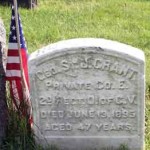
GRANT, GEORGE ST. JOHN (1848-1895). Rank unknown, 56th Regiment, New York State National Guard. A native New Yorker who lived in Brooklyn for 37 years, he served in the 56th Regiment during the Civil War. No other details of his soldier history are known. As per his obituary in the Brooklyn Daily Eagle, members of the Veteran Association, 56th Regiment, were invited to attend his funeral. He last lived at 569 Halsey Street in Brooklyn. He died from nephritis. Section 135, lot 14964, grave 856.
GRANT, JAMES (1830-1895). First lieutenant, 36th New York Infantry, Company D. Of English birth, Grant enlisted as a first lieutenant on May 13, 1861, was commissioned into the 36th New York on June 17, and mustered out on September 13, 1862. On September 12, 1863, he applied for and received an invalid pension, certificate 185,293. He last lived at 125 East 57th Street in Manhattan. Grant died of a cerebral embolism and hemorrhage. Charlotte Grant, who is interred with him, applied for a widow’s pension in 1895, application 623,104, but it was never certified. Section 114, lot 16573.
GRANT, JAMES (1841-1882). Corporal, 5th New York Infantry, Company A. Grant was born in Poughkeepsie, New York. During the Civil War, he enlisted as a private on May 9, 1861, and mustered immediately into Company A of the 5th New York. During his service, he was assigned to special duty with the Topographical Engineers. On January 1, 1862, he was promoted to corporal but then reduced to private on May 11, 1862. Although one record indicates that Pearson was discharged on May 19, 1862, due to chronic bronchitis, his muster roll reports that he was discharged for disability at camp near Henry House, Virginia, on February 27, 1863.
On June 1, 1876, Grant married Jessie Stewart Pott. As per the 1880 census, he was married and lived with his wife and daughter, Mary, at the home of his mother-in-law and his wife’s family at 154 Pearl Street in Summit, New Jersey; at that time, he worked as a machinery agent. He also worked as a merchant and speculator. He last lived in Summit, New Jersey. His death was caused by pulmonary consumption. In 1890, Jessie S. Grant applied for and received a widow’s pension, certificate 334,080. Originally interred at Green-Wood Cemetery in Lot 17402; his remains and those of two-month-old Jessie Grant were removed from Green-Wood on April 27, 1898.
GRANT, JOHN (?-?). Private, 2nd New York Infantry, Company E. He enlisted at Troy, New York, on May 14, 1861, mustered into Company E of the 2nd New York on that date, and was discharged for disability there three days later. Section ?, lot ?.
GRANT, RICHARD SUYDAM (1842-1912). Captain, 22nd Regiment, New York State National Guard, Company H. Grant, a New Yorker by birth, was a graduate of the College of the City of New York. His obituary in the New York Press, which confirms his Civil War service, reports that he joined the 22nd Regiment after his graduation. During the Civil War, he served two tours of duty, the first in 1862 when he enlisted as a captain and was commissioned at New York City on May 26. The 22nd was assigned to Virginia during that activation. He mustered out after three months on September 5 at New York City. When his unit was reactivated a year later, he re-enlisted and was commissioned into the same regiment and company on June 18, 1863. The 22nd Regiment was sent to Harrisburg, Pennsylvania, and served in the Department of the Susquehanna until July 8th when it was assigned to the Army of the Potomac. Grant mustered out with his company on July 24 at New York City after serving 30 days.
He joined the Stock Exchange on December 2, 1865. Grant was a member of the board of managers of the Delaware and Hudson Company and a director of the American Coal Company, the Cooperstown and Charlotte Valley Railroad and the Lanston Monotype Machine Company. As per his obituary in the New York Herald, he was a stockbroker at the firm R. Grant & Co at 71 Broadway. The Sun reported that when Gilbert and Sullivan visited New York City on the steamship Bothnia in the late 1800s, Arthur Sullivan visited Grant at his home. Active in many organizations, he belonged to the University, South Side, Metropolitan, Sportsmen’s, City, Down Town, and Midday clubs and the Automobile Club of America. The New York Press noted that he was also a member of Knickerbocker, Union, Racquet and Tennis and Brook clubs. The Sun published this tribute to him:
The community has lost a notable and honorable figure, and The Sun Printing and Publishing Association a valued friend, by the death of R. SUYDAM GRANT. He was a fine type of the older fashion of the New York banker and broker; a man of probity, loyalty and wide and gently exercised influence, both socially and in business affairs. His life was long and active and his acquaintance large. We record our sorrow at the loss of this associate. The great town is poorer for Mr. GRANT’S going.
His last residence was 11 Gramercy Park, Manhattan. Section 111, lot 987.
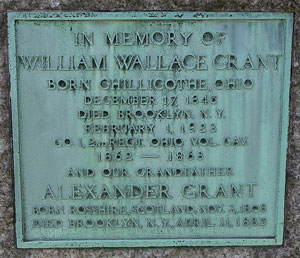
GRANT, WILLIAM WALLACE (1845-1923). Private, 2nd Ohio Cavalry, Company I; 8th Ohio Cavalry, Company K; 2nd Ohio Cavalry Battalion. Born in Chillicothe, Ohio, Grant enlisted as a private and mustered into the 2nd Ohio Cavalry on October 11, 1862, and mustered out on an unstated date. He re-enlisted as a private on March 15, 1864, mustered into the 8th Ohio Cavalry on that day, and served in the 2nd Ohio Cavalry Battalion which was activated for 60 days from August 15-October 15, 1864. He mustered out on July 30, 1865, at Clarksburg, West Virginia.
In civilian life, he was a chemist and inventor and also appeared on stage as an actor in supporting roles. His obituary in the Brooklyn Daily Eagle, which confirms his Civil War service and indicates that he served under General Ulysses S. Grant, reports that he appeared on stage with Edwin Booth (the brother of John Wilkes Booth, President Abraham Lincoln’s assassin) and Lawrence Barrett, noted dramatic actors of that era. He also acted with the Amaranth and Kemble dramatic societies of Brooklyn. The 1891 Brooklyn Directory states that he was a chemist; the censuses of 1900 and 1910 report that he was an inventor. Active in many organizations and a noted speaker, he was a commander of Ulysses S. Grant Post #327 of the G.A.R. and a grand-master in the Masonic Order of New York. He was also a member of the Square Club, the Ohio Society of New York and the American Society for the Prevention of Cruelty to Children. In 1915, he applied for and received an invalid pension, certificate 1,168,271. His funeral was held at the Grant Post’s headquarters at 439 Washington Avenue where the organization’s memorial rituals were performed. He last lived at 64 South Oxford Street in Brooklyn. His death was attributed to a cardiac condition. Section 184, lot 24935, grave 3.
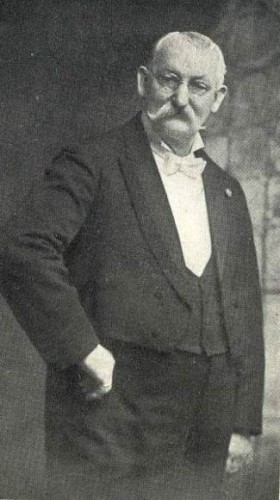
GRAU (or GRAW), ALOIS (or LOUIS, LEWIS) (1849-1922). Private, 6th New York Cavalry, Company C; 2nd New York Provisional Cavalry, Company C. Grau was born in Munich, Germany. On January 4, 1865, he enlisted as a substitute for William A. Sears and received a payment of $400. He mustered into the 6th New York Cavalry, a regiment that was present at Appomattox, Virginia, when General Robert E. Lee surrendered to General Ulysses S. Grant. Grau served until June 17, 1865, when he was transferred into the 2nd New York Provisional Cavalry under the name of Lewis Graw. He was discharged on August 9, 1865.
In 1869, he began teaching dance as Professor A. Grau. A newspaper article on July 22, 1883 in the New York Truth reported that his Terpsichorean [Dance] Academy was planning a gala at the Brooklyn Institute; a stylish affair was promised. His major professional achievement was the Carnival and Ball at New York City’s Lexington Opera House on April 30, 1913. In 1890, his application for an invalid pension was approved under certificate 511,233. Remaining active in military affairs, he was a member of Leopold Von Gilsa Post #264 of the G.A.R. He last lived in Newark, New Jersey. He died from stomach cancer. Section 185, lot 23214.
GRAY, JR., EDWARD (1829-1866). Second lieutenant, 158th New York Infantry, Company F. Originally from Cambridge, Massachusetts, and a printer by trade, Gray enlisted as a sergeant on August 22, 1862, at Brooklyn, and mustered into his company three days later. As per his muster roll, he was 5′ 9½” tall with dark eyes, dark hair and a dark complexion. The 158th was part of the Empire Brigade organized by Francis Spinola (see) and went to the front under the command of Colonel James Jourdan (see). The 158th was first sent to Norfolk, Virginia, then ordered to New Berne, North Carolina, until the fall of 1864 when it joined the Army of the James in Virginia. Gray was promoted to first sergeant on April 15, 1863, and to second lieutenant on July 15, 1863. He was wounded on September 29, 1864, at Chaffin’s Farm, Virginia, hospitalized at Fort Monroe, Virginia, and was discharged for disability on May 15, 1865. Ultimately, he died from that gunshot wound on March 11, 1866. Gray last resided on Westchester Avenue in the Tremont section of the Bronx. Section 101, lot 1588.
GRAY, GEORGE (1829-1919). Private, 79th New York Infantry, Company F. Originally from Ireland, Gray immigrated to New York in 1840. After enlisting at New York City on May 13, 1861, he mustered into the 79th on May 28. Though he is listed as a deserter on June 6, 1863, at Louisville, Kentucky, that may be incorrect; he applied for an invalid pension in 1888 under application 667,432, but there is no certification number. According to the censuses of 1870 and 1880, he was a policeman. The census of 1910 reports that he supported himself by “his own income” and indicates that he was a naturalized citizen. He last lived at 421 West 150th Street in Manhattan. He died of pneumonia. Section 174, lot 21612.
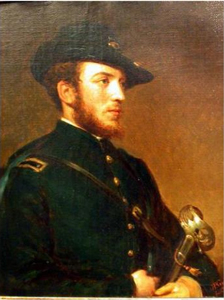
GRAY, JR., HENRY PETERS (1844-1897). Acting assistant adjutant general, 115th New York Infantry; adjutant, 103rd New York Infantry. A New York City native, his father was an acclaimed artist and one of the founders of the New York Academy of Design. Gray attended the Eagleswood Military Academy in Perth Amboy, New Jersey, but left that institution at age 17 to enlist in the Civil War in 1861. According to his obituary in The New York Times, he first served with the 115th New York as an adjutant and then was an acting assistant adjutant general under General Sheridan. He took part in numerous engagements including the Battle of Winchester, Virginia, and fought in South Carolina at Hilton Head (Port Royal), and at the bombardment of Charleston. The Times noted, “His twenty-first battle was fought on his twenty-first birthday.” He re-enlisted as an adjutant on March 18, 1864, at Folly Island, South Carolina, was commissioned into the Field and Staff, New York 103rd Infantry, and mustered out on March 17, 1864, at New York City.
After the War, Gray resumed his education and became a tutor. He was listed as a jewelry clerk on the census of 1880. The Veterans Schedule of 1890, which confirms his Civil War service, indicates that he suffered from chronic diarrhea. His obituary reports that he worked as a correspondent for Tiffany & Company for 26 years. Gray last lived in White Plains, New York. The cause of his death was listed as general paresis (impaired muscle movement). A photo of President Ulysses S. Grant addressed to Gray was recently offered for auction. Section 79, lot 1562, grave 1.

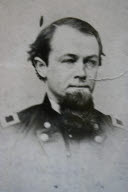
GRAY, JOHN BURRITT (1831-1896). Brigadier general and adjutant general of Missouri; colonel, 1st Missouri Infantry. Born in Sheridan, New York, he moved to Missouri as a young man and established himself in business. During the Civil War, he served with the 1st Missouri Infantry, beginning in November 1861 when he was lieutenant colonel on the staff of General Halleck. In 1862, he was commissioned colonel and sent to command the Union post at Pilot Knob, Missouri, a strategic location that protected against the advance of Confederates and included guard stations along the Iron Mountain Railroad. In March 1863, Gray was promoted to brigadier general and appointed adjutant general of Missouri.
At the close of the Civil War, Gray was successful in procuring a $7 million reimbursement from the federal government for the expenses borne by the state of Missouri. He turned down requests to run for office and declined positions offered by Presidents Andrew Johnson and Ulysses S. Grant. Returning to business in St. Louis, he became wealthy wholesaling hats, furs, and gloves. In 1883, he became vice president of the American Brake Company that later became the Westinghouse Corporation. Two years later, the company asked him to relocate to New York City, and he resided at 513 West 3rd Street in Brooklyn. As per his obituary in the New York Tribune, he belonged to the Logan and Union League Clubs and the Military Order of the Loyal Legion, a patriotic organization. He died of Bright’s disease in Asheville, North Carolina, while on vacation to restore his health. His funeral was held at the First Reformed Church on Seventh Avenue and Carroll Street in Brooklyn. Section P, lot 22310.

GRAY, JOHN FREDERICK SCHILLER (1845-1891). Major by brevet; captain and assistant adjutant general, United States Veteran Volunteers; captain, 20th New York Infantry, Companies E and A. Gray’s father, John Franklin Gray, was a prominent homeopathic physician. After enlisting as a second lieutenant at Washington, D.C., on September 6, 1862, he mustered into the 20th on that same date. According to the papers of Walt Whitman, Gray fought at the Battle of Antietam, Maryland, and gave Whitman a “fearful account” of that engagement at Charles Pfaff’s beer cellar in Lower Manhattan. Gray was promoted to captain on December 5 effective upon his transfer to Company A. On May 13, 1863, he mustered out and became assistant adjutant general with the rank of captain in the United States Veteran Volunteers. Whitman’s notebooks indicate that Gray was in New Orleans, Louisiana, during 1864. An article in the Philadelphia Inquirer on April 3, 1865, reported that Major Gray and General Edward Canby visited Admiral Henry Thatcher on his flagship, the Richmond. Gray resigned on May 5, 1865. His “faithful and meritorious service” was rewarded on January 4, 1865, when he was brevetted to major.
Gray graduated from New York City’s College of Physicians in 1871 and briefly practiced with his father in New York City, before practicing in Paris, Nice and Geneva. An article in the New York Herald on August 17, 1882, notes that Gray was bequeathed by his father an annual income of $3,000. In addition, Gray bequeathed a bookcase of Latin classics, jewelry, artwork and money to his children and extended family. A resident of San Diego, California, in his later years, Gray died in St. Clare, Michigan, of Bright’s disease. Section 20, lot 4050.

GRAY, JOHN N. (1841-1871). Private, 9th New York Infantry, Company F. Of Canadian origin, Gray enlisted as a private at New York City on April 23, 1861, and mustered into Company F of the 9th New York, also known as Hawkins’ Zouaves, on May 4. The regiment was detached at Plymouth, North Carolina, from June through November 1862. He was taken as a prisoner of war on September 23, 1862, place not stated, returned three months later on December 23, and mustered out at New York City on May 20, 1863.
The 1870 census reports that Gray was a compositor. As per his obituary in the New York Herald, members of his company and regiment as well as members of the Typographical Union were invited to attend his funeral. According to his obituary in The New York Times, an escort of 16 men from his regiment under the command of Captain J. C. Julius Langbein of the 1st Regiment National Guard formed a bodyguard around the hearse. The obituary ended with the quote, “He sleeps his last sleep, he has fought his last battle; No sound can awake him to glory again.” His funeral, which was well attended, was held at the home of his brother-in-law at 49 Suffolk Street in Manhattan. The cause of his death was consumption. Section 127, lot 3611, grave 20.
GRAY, WILLIAM (1835-1872). Private, 170th New York Infantry, Company D. Originally from England, Gray enlisted at New York City as a private on September 13, 1862, and mustered into the 170th New York on October 7. He was discharged for disability on October 6, 1864. His last residence was at 321 Delancey Street in Manhattan. He died of phthisis. Section 126, lot 7639, grave 276.
GRAY, WILLIAM C. BRYANT (1840-1863). First lieutenant and aide-de-camp, 4th New York Heavy Artillery, Battery D. Gray enlisted as a first lieutenant on January 4, 1862, and was commissioned into Battery D of the 4th Heavy Artillery on that day. As per his muster roll, he was 5′ 5″ tall with blue eyes, light hair and a light complexion. His soldier record states that he was an aide-de-camp to General Abner Doubleday. He died of disease on January 1, 1863, at the Seminary Hospital at Georgetown, D.C., although another source, Abner Doubleday: His Life and Times: Looking Beyond the Myth by JoAnn Smith Bartlett, reports that he died at Fort Ethan Allen, in Alexandria County, Virginia. (No battle took place at this site but it was constructed to defend the nation’s capitol and was visited by President Abraham Lincoln.) Gray’s diary is available at the City College of New York. His death was attributed to typhoid fever. The funeral was held at the home of his father at 49 West 37th Street in Manhattan. Section 25, lot 3487.
GRAY, WILLIAM H. (1844-1912). Private, 13th Regiment, New York State Militia, Company D. A native of New York, the 1860 census reports that he was employed as a wire braider. After enlisting in 1861, Gray served as a private in the 13th Regiment for three months. According to the census of 1870, he was a syrup manufacturer; the census of 1900 indicates that he was a manufacturer. In 1904, he applied for and received a pension, certificate 1,100,639. As per the census of 1910, he was working in real estate.
Gray’s obituary in the Brooklyn Daily Eagle, which confirms his Civil War service, refers to him as a captain who served throughout the hostilities; this is not validated by his soldier record. The obituary also indicates that he was in the brokerage business dating from the 1860s; this is not validated by the census records. He last lived at 944 East 15th Street in Brooklyn. He died of heart disease. Phila Gray, who is interred with him, was granted a widow’s pension after his death in 1912, certificate 745,076. Section 36, lot 107.
GREELEY, HORACE (1811-1872). Founder and editor of the New York Tribune, political leader. He was born in Amherst, New Hampshire, and apprenticed to a printer. When that printer went out of business in 1831, Greeley set off, with $25 and his possessions in a handkerchief, for New York City. He worked a succession of jobs there, edited several publications, then founded the New York Tribune in 1841, which he edited for the rest of his life. His aim was to create “a journal removed alike from servile partisanship on the one hand, and from gagged, mincing neutrality on the other.” Soon widely known for his ideals and moral fervor, he advocated many causes, including worker’s rights, women’s rights (though not woman’s suffrage), scientific farming, free distribution of government lands, and the abolition of slavery and capital punishment. By the late 1850s the Tribune had a national influence as great as any other newspaper in the country, particularly in the rural North. The Tribune was the first American newspaper to employ women reporters who wrote under their own byline, introduced American readers to Charles Dickens, published Edgar Allan Poe’s “The Raven,” and gave Karl Marx, Greeley’s foreign correspondent in London, his first exposure to an audience in this country.
Greeley was known for his enthusiastic inconsistency, criticizing Lincoln for his “obstinate tameness” and urging him “Forward to Richmond” before Bull Run, the first battle of the Civil War, then urging armistice and disbanding of the Union Army immediately thereafter. After the Civil War, he urged amnesty for Southerners and provided part of the bail to get Confederate President Jefferson Davis out of jail. Greeley coined the phrases “Know-Nothings” and “Copperheads,” and told the unemployed during the Panic of 1837 to “Go West, young man, and grow with the country.” He was long in the public eye, was admired by many, and was viewed with affectionate amusement by others. Greeley was a familiar figure on New York’s streets, wearing a wrinkled white coat, his pockets stuffed with newspapers. But he always wanted very much to be a statesman. He served in Congress as a Whig for three months 1848-1849, but ran unsuccessfully for the House of Representatives in 1850, 1868, and 1870, and for the United States Senate in 1861 and 1863. The political career of “Old Chappaquack” (as he was popularly known) ended tragically with his campaign for President as the candidate of the Democrats and the Liberal Republicans in 1872, in which he urged leniency for the South, equal rights for white and blacks, and thrift and honesty in government; he was attacked as a traitor, fool, and crank. During this campaign he was referred to by noted cartoonist Thomas Nast as “Horrors Greeley.” His wife of thirty-six years (whom he met at a vegetarian boarding house in New York City) died two weeks before the election. He was soundly defeated by Grant at the polls, and he returned to his beloved Tribune only to discover that its control had passed to Whitelaw Reid. Greeley died shortly thereafter.
His funeral on December 4, 1872, was attended by President Grant, cabinet members, governors of three states, and an outpouring of mourners who knew him as a beloved public figure. Greeley wrote his own epitaph: “Fame is a vapor; popularity an accident; riches take wings; the only earthly certainty is oblivion; no man can foresee what a day will bring forth; while those who cheer today will often curse tomorrow; and yet I cherish the hope that the journal I projected and established will live and flourish long after I have mouldered into forgotten dust . . . and that the stone which covers my ashes may bear to future eyes the still intelligible inscription, Founder of The New York Tribune.” The Tribune published its last New York edition on August 15, 1966. Greeley Square, just south of Herald Square in Manhattan, is named in his honor. Section 35, lot 2344.

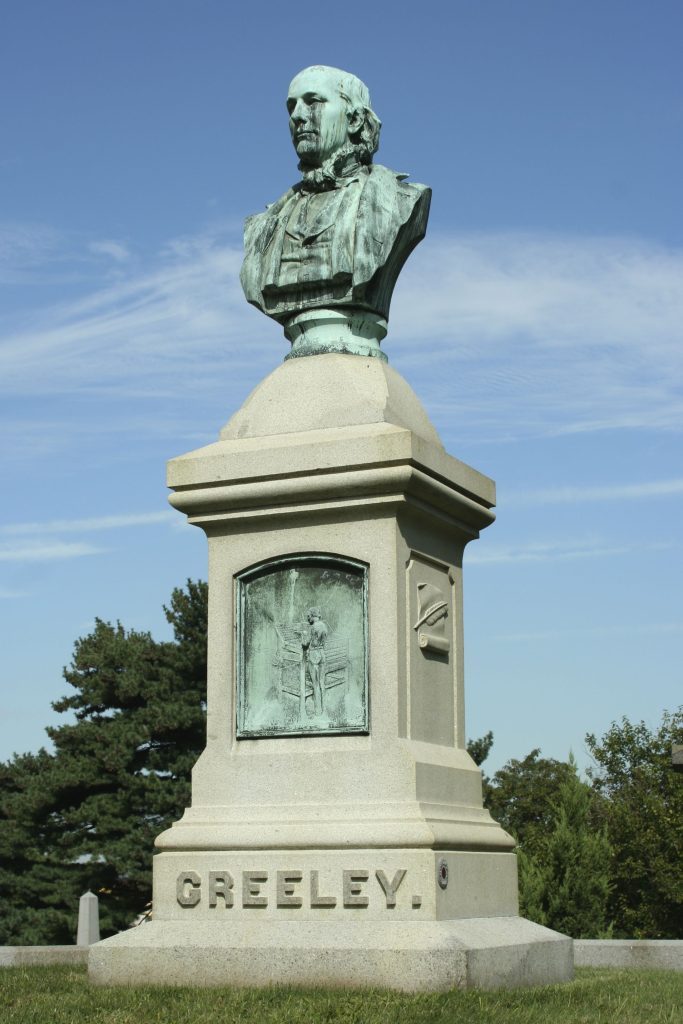
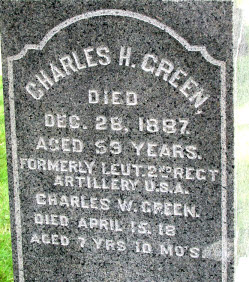
GREEN, CHARLES H. (1821-1887). Second lieutenant, 5th United States Artillery, Company C (Regular Army); sergeant, 1st United States Artillery. Green, a New Yorker by birth, first served in the Mexican War. He enlisted at New York City on May 7, 1847, mustered into Company K of the 2nd United States Artillery, and was discharged on August 17, 1848, at Governors Island, New York. Later that year, he re-enlisted on November 18 and served as a private, corporal and sergeant in the 1st Artillery, Company B, of the United States Army serving much of the time in Florida until his discharge on November 18, 1853. Subsequently, he was a private and then sergeant of general services in that regiment’s quartermaster division from October 13, 1855 through August 14, 1863.
In a letter to the Adjutant General of the U.S. Army dated June 17, 1863, Green asked for a commission to second lieutenant citing his service of close to 14 years with duty in Mexico and Florida and added supporting recommendations attesting to his faithful duty from numerous commanding officers. On August 17, 1863, he was transferred into the 5th Artillery of the United States Army where he served as a second lieutenant until his resignation on December 19. In his letter of resignation, he cited kidney problems and mental incompetence, having had no previous service with a light battery.
In civilian life, he was a conductor. A pension was issued to him based on his duty in the Mexican War, certificate 11,431. His pension application cited that cataracts prevented him from earning a living. He last lived at 348 West 53rd Street in Manhattan but died in a New York insane asylum. In 1888, Julia Green applied for and received a widow’s pension, certificate 4,535. Section 61, lot 1 1490.

GREEN (or GREENE), EDMUND R. (1830-1878). Captain, 83rd New York Infantry, Company D. Originally from Providence, Rhode Island, Green enlisted as a first lieutenant at New York City on May 27, 1861, and was immediately commissioned into Company D of the 83rd Infantry. On August 5, 1861, he was promoted to captain of his company, but did not muster in at that rank. He was discharged from military service on May 22, 1862. He last lived in Wickford, Rhode Island. His death was caused by consumption. Section 71, lot 832.
GREEN, FRANCIS G. (1830-1904). Private, 17th New York Infantry, Company F. A native New Yorker, he enlisted there as a private on August 18, 1863, mustered into the 17th New York on October 13, and mustered out on July 13, 1865, at Alexandria, Virginia. He last lived at 1 West 80th Street in Manhattan. His death was attributed to cirrhosis. Section 99, lot 10266.
GREEN (or GREENE), HARRY S. (1839-1863). Captain, 52nd Regiment, New York State National Guard, Company H. As per Adjutant General Department records of officers, Green served as captain of the 52nd Regiment in 1862. He re-enlisted as a captain on June 19, 1863, was commissioned into the 52nd Regiment that same day, and mustered out July 25, 1863, at Brooklyn. He last lived at 337 Fulton Street in Brooklyn. His death was attributed to bilious remittent fever. Interred in lot 871, grave 15, within days of his death, his remains were moved on October 11, 1864. Section 188, lot 15330.
GREEN, JOHN (1805-1864). Carpenter, United States Navy. Green, a native of New England and a resident of New Hampshire, served as a carpenter in the Navy beginning on January 23, 1833. During his service, he was aboard the USS Mississippi. He died from consumption in Charlestown, Massachusetts, in 1864. Section E, lot 20368.
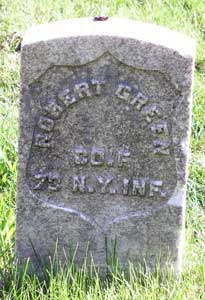
GREEN, ROBERT (1840-?). Private, 73rd New York Infantry, Companies C and F. After enlisting at New York City on September 20, 1861, he mustered into the 73rd New York the next month on October 8, was transferred into Company F, and mustered out on June 29, 1865, at Washington, D.C. Section 64, lot 4558.

GREENE, AUGUSTUS P. (1827-1905). Colonel and major by brevet; captain, 15th New York Engineers, Companies K and A. A New Yorker by birth, Greene served in the Mexican War in 1848. In civilian life, he was in the dry goods business. During the Civil War, he organized a company then enlisted as a first lieutenant on June 17, 1861, at Willets Point, New York, and was commissioned into Company K of the 15th New York Engineers on that day. His unit erected fortifications for the defense of Washington, D.C., in 1861, built bridges and opened roads from Chickahominy to Harrison’s Landing, Virginia, and then erected pontoon bridges from December 1862-spring 1863. Greene was promoted to captain on March 14, 1863, effective upon his transfer to Company A, and mustered out at New York City on June 25, 1863. “Gallant and meritorious service in the late War” earned him promotions by brevet to major on September 4, 1866, and to colonel on March 22, 1867.
He had subsequent service as a second lieutenant in the 14th Infantry, United States Army as of July 20, 1866. On May 1867, he was promoted to first lieutenant. He was the acting assistant quartermaster and assistant commissary of subsistence at Fort Yuma, California, as of June 1867. Greene was appointed an agent to the Mission Indians on October 6, 1869. On August 30, 1870, he submitted a report to the Department of the Interior as a special Indian agent. He concluded:
…In my opinion, the Mission Indians in Southern California are retarding the development of that part of the State, inasmuch as they are in possession of public lands which they do not and will not cultivate to any reasonable extent. Therefore I would most respectfully recommend to the Government of the United States either to compel them to locate forthwith on the designated reservations, in order to leave the land which they occupy to white settlers, or to make citizens of them, to take their chances in the race of life along with the white and black races of the country.
Greene was court-martialed on December 13, 1872, and charged with disorderly conduct, public intoxication while in uniform, and profane speech on December 2, 1872, when he was in San Francisco, California, at the Presidio and at the Occidental Hotel. Found guilty on all counts, his sentence stated that he was to be removed as an officer and dismissed from the Army; this became official on March 28, 1873. Greene’s initial appointment to the U.S. Army was also marked by controversy. On June 12, 1876, charges were brought against Michael C. Kerr alleging that Kerr, while a member of the 39th Congress representing Indiana, accepted $450 to appoint Greene to his position in the U.S. Army in 1866. The investigation exonerated Kerr who claimed that Greene had the proper credentials and recommendations. Greene, while admitting he gave money to a middleman, Lawrence Harney, claimed that he knew nothing of the transaction. It was determined that Harney’s conflicting statements cleared Kerr of any wrongdoing.
In 1892, his application for an invalid pension was approved under certificate 1,057,888. According to the census of 1900, Greene was in the real estate business. As per his obituary in the Evening Post, which confirms his Civil War service, he was active in military circles, having been commander of the H. A. Weeks Post of the G.A.R. and member of the Lafayette Post #140. He was also a Freemason and member of the Veteran Legion. His last residence was 602 East 139th Street in the Bronx.
Controversy continued to plague Greene after his death from cancer. According to an article in the Sun on July 6, 1905, Genevieve Greene, a California woman, claimed to be his widow and declared that she was entitled to be enriched by his $200,000 estate. Although the two were not living together in New York, she said that Augustus Greene had provided her with his attorney’s name and stated, “…We had a thorough understanding. He told me he was prosperous and that you were his attorney, and if anything should happen to him that he would arrange it with his lawyer that I would be provided for. I have letters and data that prove what I say and will prove my relationship to him….” She said that the two were married in Arizona and that she last saw him in Pasadena, California, in 1903, when he was on a G.A.R. retreat. The article in the Sun, which noted Greene’s Civil War service, reports that Greene owned the building in which he lived and $180,000 in other real estate. The bulk of his estate was left to his nephew, an adopted son, and numerous grandnephews and grandnieces. Section 50, lot 7899, grave 15.
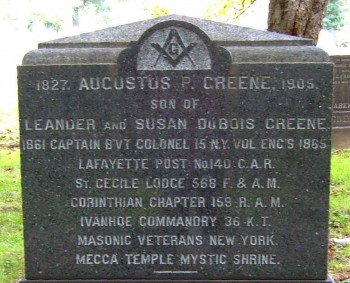
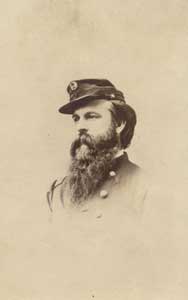
GREENE, ELIAS M. (1831-1899). Lieutenant colonel and quartermaster, United States Volunteers Quartermaster’s Department. Born in New York City, Greene served in the Mexican War, then was employed as a merchant in crockery and clothing before the Civil War. Greene enlisted as a captain on October 3, 1862, and was commissioned immediately as a captain and assistant quartermaster in the United States Volunteers Quartermaster’s Department. That same day, he was promoted to lieutenant colonel and quartermaster.
Roger Hunt included details of Greene’s service in his latest book in his “Colonels in Blue” series; it is subtitled, U.S. Colored Troops, U.S. Armed forces, Staff Officers and Special Units (McFarland Press). As per Hunt’s biographic information, Greene served as chief quartermaster on the staff of Major General Samuel P. Heintzelman in the Military District of Washington from October 1862 through February 1863, and then was chief quartermaster of the Department of Washington until August 1864.
As per the Arlington [Virginia] Historical Society, on May 5, 1863, Greene and Danforth B. Nichols of the American Missionary Association, officially selected the Arlington Estate, part of the property of General Robert E. Lee, as the site of Freedman’s Village, an intended model community for freed persons. (On April 16, 1862, Congress passed legislation freeing slaves in Washington, D.C., prior to the enactment of the Emancipation Proclamation of January 1, 1863.) The National Park Service website notes that Greene wrote to Heintzelman of the freedmen, “There is the decided advantage afforded to them of the salutary effects of good pure country air and a return to their former healthy avocations as field hands under much happier auspices than heretofore which must prove beneficial to them and will tend to prevent the increase of disease now present among them.” Within a few weeks, 100 former slaves, now freedmen, settled on what had been Lee’s estate. Greene tendered his resignation from the military on November 17, 1864 citing “a two-year absence from my home has increased the confusion of my private affairs.” He mustered out on July 28, 1865.
In civilian life, Greene was involved in numerous business enterprises including service as vice-president of the Magneto-Electric Manufacturing Company. His last residence was 726 Broadway in Manhattan. He died of a hemorrhage. Section K, lot 15977, grave 11.
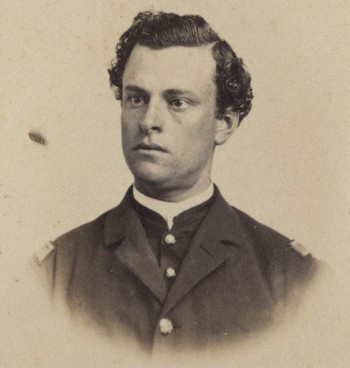
GREENE, WILLIAM A. (1840-1911). Lieutenant colonel and major by brevet; captain, 173rd New York Infantry, Companies B and D; private, 8th Regiment, New York State Militia, Company F. Born in New York City, he enlisted there on April 23, 1861, and mustered into the 8th New York State Militia. After being taken as a prisoner of war at the Battle of Bull Run, Virginia, on July 21, 1861, he was incarcerated at Tobacco Warehouse (Libby Prison) in Richmond, Virginia, at Tuscaloosa, Alabama, and at Salisbury, North Carolina. He was released on May 30, 1862, at Governor’s Island, New York Harbor. Greene re-enlisted at Brooklyn on September 18, 1862, was commissioned as a second lieutenant into Company B of the 173rd New York, and was transferred to Company D on March 26, 1863, the day after he was promoted to first lieutenant. Promoted to captain on January 25, 1864, he was transferred back to Company B. His regiment was involved in numerous skirmishes in the Red River Campaign in 1864. On April 23, 1864, he was wounded at Cane River Crossing, Louisiana, and later served in the Shenandoah Campaign under General P. H. Sheridan before he mustered out on October 18, 1865, at Savannah, Georgia. Greene was brevetted major on May 23, 1866, “for gallant and meritorious conduct at the siege of Port Hudson, Louisiana, to date from March 13, 1865.” He was also brevetted lieutenant colonel “for gallant and meritorious service at the Battles of Sabine Cross Roads, Pleasant Hill and Cane River Crossing, Louisiana, to date from March 13, 1865.”
In civilian life, Greene was associated for about forty years with the Custom House in New York; this position is noted in the New York City Directory for 1878. In 1880, his application for an invalid pension was granted, certificate 222,757. The New York City Directory of 1900 and the 1910 census report that he was an inspector at the Custom House. As per his obituaries in the Brooklyn Daily Eagle and the Brooklyn Standard Union, which confirm his Civil War service, he was a charter member of Henry M. Lee Post #21 (organized January 20, 1870) and held the post of commander at some point. A Freemason, he also belonged to the De Witt Clinton Commandery and the Mansfield Post #35 of the G.A.R. In his personal sketch in the G.A.R. book, he lists the officers of the 173rd as his “intimate comrades.” He last lived at 178 Clymer Street but his funeral was held at his daughter’s residence in Canarsie, Brooklyn. Greene died of heart disease. In 1911, Jane Greene, who is interred with him, applied for and received a widow’s pension, certificate 721,476. Section 109, lot 9479.
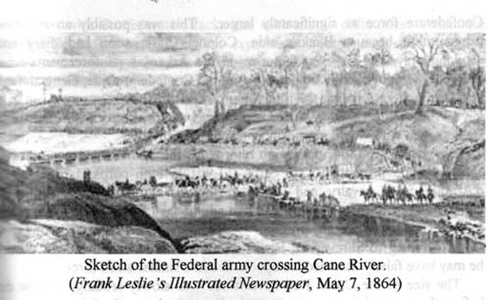

GREENFIELD, JAMES H. (or A.) (1841-1893). Corporal, 22nd Regiment, New York State National Guard, Company F. Greenfield, who was born in New York State, was listed as a clerk on the 1860 census. During the Civil War, he enlisted as a corporal on May 28, 1862, at New York City, and mustered into the 22nd Regiment for three months. He mustered out of service on September 5 at New York City.
The 1870 census notes that he was a clerk in a store. In 1885, Greenfield was a bookkeeper in Orange, New Jersey. The Veterans Schedule of 1890 confirms his Civil War service. As per his obituary in the New York Herald, he was a member of Colonel James Monroe Post #607 of the G.A.R. and War Veterans of the 22nd Regiment; comrades were invited to attend his funeral. His last residence was 24 Hamilton Street in East Orange, Essex County, New Jersey. His death was due to pulmonary phthisis. In 1909, Mary Greenfield applied for and received a widow’s pension, certificate 687,859. Section 13, lot 9498, grave 3.
GREENLEAF, JR., ALFRED (1836-1891). Second lieutenant, 87th New York Infantry, Company G; 159th New York Infantry, Company B. A native of Salem, Massachusetts (although his muster roll incorrectly says Brooklyn), he was the brother of Charles Greenleaf (see). Greenleaf’s father, also named Alfred, was an educator who opened the Institute for Young Ladies, a first for Brooklyn women, on Clinton and Pierrepont Streets in 1844. Alfred Greenleaf was living with his parents as per the census of 1860 and working as a conductor. After enlisting as a second lieutenant at Brooklyn on September 4, 1861, he was commissioned into the 87th on December 2 of that year. His muster roll reports that he was 5′ 8″ tall with brown eyes, black hair and a fair complexion. He was discharged on May 1, 1862. He re-enlisted on September 24, 1862, at Brooklyn, and was commissioned into the 159th on that day. According to his muster roll, he was detached to the Louisiana Cavalry on October 10, 1863, and resigned on May 2, 1864.
The census of 1870 and the Brooklyn Directory for 1886 report that Greenleaf was an engineer; the 1880 census indicates that he was a machinist. In 1890, his application for an invalid pension was approved, certificate 517,016. His last Brooklyn address was 36 Kent Avenue but he was admitted to the National Home for Disabled Volunteer Soldiers in Hampton Roads, Virginia, in 1889. The Veterans Schedule of 1890 confirms his Civil War service and notes that his heart disease and rheumatism were contracted during his military duty. Section 61, lot 108.

GREENLEAF, CHARLES HOW (1838-1913). Second assistant engineer, United States Navy. Born in Brooklyn where he resided on Washington Avenue, Greenleaf enlisted in the Navy as a third assistant engineer on October 3, 1861. He left for Mystic, Connecticut, where he boarded the USS Owasco, a gun boat in the Gulf Squadron, and remained with that vessel until December 1863. He rose through the ranks becoming a second assistant engineer on August 3, 1863, and was promoted to first assistant engineer on October 11, 1866.
In the 1870s, while still on active duty, he became a professor of Steam Engineering at the United States Naval Academy at Annapolis, Maryland. His service in the Navy was uninterrupted until he retired on July 18, 1885. His brother, Alfred Greenleaf (see), was also a veteran of the Civil War. He last resided in Chelmsford, Massachusetts. Greenleaf died of angina pectoris. Section 61, lot 108.
GREENOUGH, DAVID (or DANIEL) I. (1836-1909). Private, 22nd Regiment, New York State National Guard, Company A. A native of Boston, Massachusetts, his soldier record used the first name of “Daniel.” Greenough served for 30 days in the 22nd Regiment in 1863. The census of 1870 and the Brooklyn Directories of 1878 and 1882 indicate that he was an auctioneer. The Veterans Schedule of 1890 confirms his Civil War service. He was working as an auctioneer as per the census of 1900. In 1896, his application for an invalid pension was approved, certificate 973,350. His last address was on Amsterdam Avenue in Manhattan. The cause of his death was arteriosclerosis. Emma Greenough applied for and received a widow’s pension in 1909, certificate 700,696.
An article in the Buffalo Courier on August 28, 1922, noted that Emma Greenough, a widow who had moved to Corning, New York, was found dead in her apartment with a week-old newspaper on her lap. Her body was found after neighbors reported that she had not been seen in several days. The article in that paper and in Corning’s Evening Leader noted that her husband was a Civil War veteran. Section 90, lot 2459.
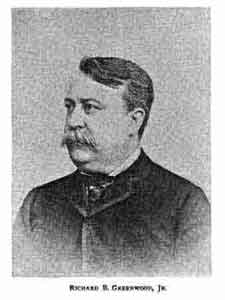
GREENWOOD, RICHARD B. (1843-1915). Private, 22nd Regiment, New York State National Guard, Company H. A native New Yorker, he was a graduate of the College of the City of New York and Columbia Law School. He enlisted at New York City on May 28, 1862, mustered immediately into the 22nd National Guard, and mustered out after three months on September 5. When his unit was reactivated a year later, he served in the same regiment and company for 30 days.
Greenwood, who spent some time in Chicago after his graduation from law school, returned to Brooklyn where he was an assistant corporation counsel for Brooklyn and was associated with the Corporation Counsel’s office for 40 years. In 1908, his application for an invalid pension was approved, certificate 1,151,300. He was a member of the James Monroe Post #607 of the G.A.R. and its commander for six years. He last lived at 241 West 22nd Street in Manhattan. He succumbed to cancer. Section 52, lot 9095.
GREER, JAMES (1826-1872). Private, 36th New York Infantry, Companies K and I. An Irish native, Greer was employed as a dyer according to the census of 1860 and had a personal worth of $600. During the Civil War, he enlisted at New York City as a private on June 20, 1861, and mustered into Company K of the 36th New York four days later. He was transferred intra-regimentally to Company I on June 25, and was discharged on an unknown date. The census of 1870 indicates that Greer was living in New York City and working as an engineer. He last lived at 324 West 21st Street in Manhattan. He died of cirrhosis of the liver. Section 17, lot 17245, grave 1032.
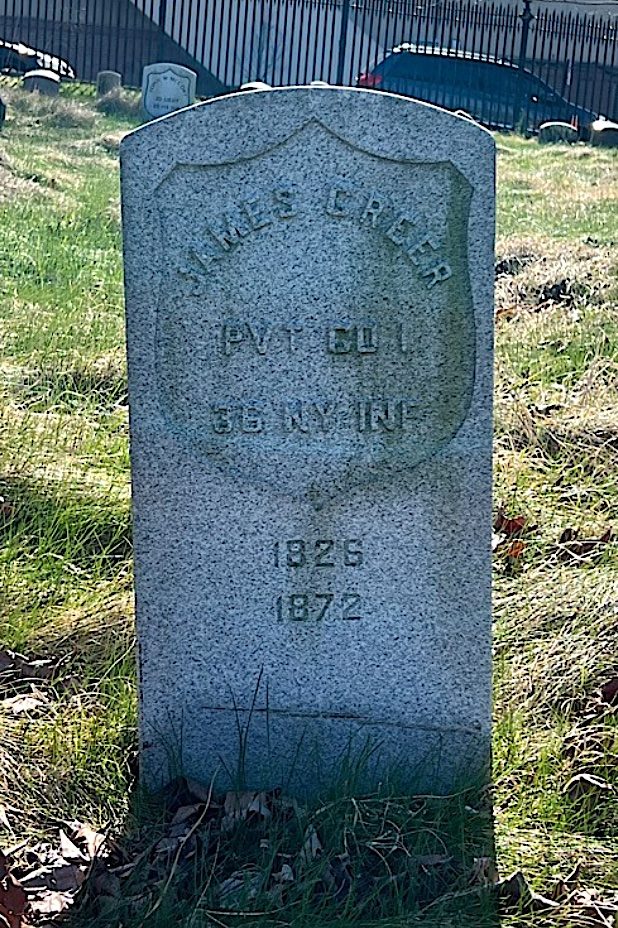

GREGORY, BENJAMIN (1839-1885). Major and additional paymaster, United States Volunteers, Paymaster’s Department, adjutant and first lieutenant, 2nd New York Cavalry, Companies A and H; private, 7th Regiment, New York State Militia, Company B. Originally from Jersey City, New Jersey, Gregory and his brother Dudley (see) were two of fourteen children born to their parents, Dudley S. Gregory and Ann Marie Lyon Gregory. His father was the first mayor of Jersey City, serving from 1838-1840, 1841-1843 and then from 1858-1860. Dudley S. Gregory was also a Whig Congressman who served 1847-1849. During his father’s tenure, Jersey City became an industrial city and transportation hub and expanded public education and social services. Gregory’s uncle by marriage was the noted painter George Catlin whose specialty was portraits of Native Americans in the Old West. As per the census of 1860, Benjamin was a clerk living at home with his parents.
During the Civil War, Benjamin Gregory enlisted at New York City as a private in 1861 and served in the 7th Regiment for 30 days, mustering out when his enlistment expired. An article in the Brooklyn Daily Eagle on April 21, 1861, reported that Benjamin Gregory of the 7th Regiment killed a secessionist in a Baltimore, Maryland, saloon. However, the last line in the article reads, “We have last heard this report contradicted.” On August 12, 1861, he was commissioned into Company A of the 2nd New York Cavalry as a second lieutenant, rose to first lieutenant effective upon his transfer to Company H on an unknown date, and was promoted to adjutant on April 1, 1862. He was discharged from military service on October 31, 1862. Most likely, he is the Benjamin Gregory who enlisted as a major on September 18, 1863, was promoted to major and additional paymaster that same day when he was commissioned into the U.S. Volunteer’s Paymaster’s Department and resigned on July 9, 1864.
The 1870 census states that Benjamin Gregory was living in Jersey City and employed in steel works. When Gregory’s father died in 1874, Benjamin and his three brothers were bequeathed equal shares in Adirondack Steel, but no annuity; his share of the million dollar inheritance was squandered. Gregory was involved in a scandal reported in the Evening Post on March 17, 1875, and in the New York Herald on March 18, 1875. Both articles report that Gregory, a married man with children, was intimate with Mrs. Annie Josephine Curtis, a 24 year-old singer in the Church of the Atonement, where he was an organist. Ms. Curtis died after a botched abortion, but, although Gregory was held on $1,000 bail, he was exonerated after the evidence established that Gregory did not send Ms. Curtis for the operation and did not know about its occurrence. (His wife filed for a divorce in September 1883, citing numerous infidelities, although other records show he married an Ellen Curtis in October 1881.)
Remaining active in military affairs, Gregory was commissioned captain in the 22nd New York State National Guard on November 8, 1879, and remained in that position until January 9, 1883. The 1880 census reports that he was a steel merchant living in New York City. However, articles in New York Sun on January 14, 1881, and New York Tribune on January 21, 1881, report business troubles between brothers Benjamin and Dudley Gregory at Adirondack Steel imperiling the standing of the company. Assets were said to be $300,000 and liabilities “undetermined”; Benjamin Gregory was put in charge until obligations could be met. According to his obituary in the New York Herald, which confirms his squandering of his father’s fortune, Gregory was an accomplished organist and magician. He performed his skills of legerdemain for the benefit of churches and other charitable groups. In addition, he was an organist at the Grace Church on 116th Street in Manhattan. That obituary reports that he was a captain in the 22nd Regiment and then a major in the 4th Regiment of New Jersey. His last residence was 363 West 51st Street in Manhattan. The cause of death was pneumonia and typhoid fever. In 1885, his widow, Emma F. Gregory, applied for a pension, application 333,122, but there is no certificate number. Section 182, lot 15396.
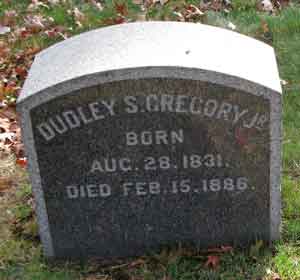
GREGORY, JR., DUDLEY SANFORD (1831-1886). First lieutenant, 71st Regiment, New York State National Guard, Company A. Born in New York City, Gregory’s family moved to Jersey City, New Jersey, when he was an infant. His father, who bore the same name, was a Congressman and three-time mayor from Jersey City, as well as an entrepreneur who accrued great wealth in the fields of insurance, banking and railroads. His uncle, by marriage, was George Catlin, the noted painter of Native Americans. In 1850, the younger Gregory was not working but apparently was a catcher for the Pioneer Club, a short-lived baseball team. He may have also played for the Eagle Club in New York. Like other baseball players on the Pioneer Club team, he was part of the Volunteer Fire Department in Jersey City, serving as foreman of Empire Hook & Ladder Company Number 1.
A Republican, Dudley Gregory Jr. was a member of the State Legislature in New Jersey representing the 1st Assembly District from 1855 through 1861. One source indicates that Gregory was appointed a colonel in the New Jersey State Militia in 1849. Although this information is questionable, he is referred to as Colonel Gregory in a description of Abraham Lincoln’s visit to New Jersey after his election. In that account, Gregory gave the order to Dodsworth’s Band to play The Star-Spangled Banner as the President-elect and his entourage boarded the “Presidential Special” pulled by the locomotive Governor Pennington.
During the Civil War, Gregory enlisted at New York City as a first lieutenant and served in the 71st Regiment for three months in 1862. The census of 1870 indicates that he was a real estate agent whose property was valued at $250,000 and whose personal worth was $200,000. He and his brothers established Gregory & Co., a steel works. As per his obituary in the New York Herald, he was a well-known soldier, politician and resident of Jersey City. According to his obituary in The New York Times, his father left him and his brothers a million dollar fortune that they squandered. His obituary in the New York Tribune reports that Sanford became a “leading spirit of society” after his father’s death and lived in a large house that was later purchased by the U.S. government and converted into a post office. Remaining active in the Republican Party and continuing as a volunteer fireman, he served at one point on Jersey City’s Board of Finance, and was president of the Board of Fire Commissioners 1871-1872 when a paid organization replaced a Volunteer Fire Department.
Dudley S. Gregory Jr. was a founder of the Philharmonic Society in Jersey City (whose roots were established in his local church’s choir) and president of the Jersey City Board of Fire Commissioners. The obituary in The New York Times states that he was a colonel of the 2nd New Jersey during the War prior to his enlistment in the 71st Regiment but this is not substantiated; the New York Tribune also notes that he was a colonel in the militia but provided no other details. The census of 1880 indicates that he was living in Bay Shore, New York, but not working. The last years of Dudley Gregory’s life were marked by controversy and confused behavior. The New York Tribune cites that he and his wife separated after domestic troubles and that he appeared confused in public. In one instance, he threw thousands of dollars worth of ten-dollar bills in the cabin of a Pennsylvania Railroad ferry boat and into the river before he attempted to jump from the bow of the vessel as it neared the shore. He lost a large part of his fortune through speculative deals and, in the last year of his life, shot himself in the side. He applied for an invalid pension in 1884, application 518,895, but there is no certificate number. He was the brother of Benjamin Gregory (see). His last address was in Jersey City, New Jersey.
On March 11, 1886, an article in the Times (Troy, New York) reports that New York Hospital, one of the oldest and richest hospitals in New York City, treated 3,508 patients in the last year, one of whom was Dudley S. Gregory. The article went on to say that Gregory’s father was one of the richest men in Jersey City whose loan of $1,000 enabled Horace Greeley to establish the New York Tribune. The article concluded, “His son (of the same name) followed the course of rich men’s children, and eventually sought refuge in the hospital, which he only left in his coffin.” He died of liver cancer. Section 182, lot 15396.
GREGORY, FRANK (or FRANCIS) F. (1844-1897). Acting ensign, United States Navy. Originally from Marblehead, Massachusetts, he was a fisherman living there at the time of the 1860 census. Gregory enlisted on April 27, 1864, the same day that he was appointed an acting ensign in the United States Navy. He was discharged on July 18, 1865.
As per his obituary in the Brooklyn Daily Eagle, which confirms his Civil War service, he was the superintendent of the Jersey Central Ferry; its terminal was at the foot of Liberty Street in Manhattan. Gregory was a member of the Ulysses S. Grant Post #327 of the Grand Army of the Republic as of April 22, 1884, and was well-known in the organization. A Freemason, he was also a member of the West End Council and was the superintendent of the Atlantic Yacht Club. He applied for and received a pension from the Navy, certificate 25,324. The Veterans Census of 1890 confirms his Civil War service. His last residence was 215 53rd Street in Brooklyn. Cancer was the cause of his death. Viola Imogene Gregory, who is interred with him, applied for and received a widow’s pension, certificate 12,348. Section 59, lot 11734, grave 93.
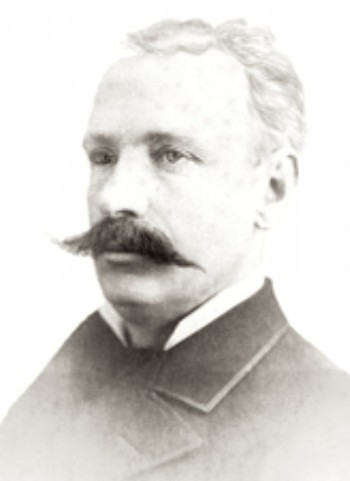
GREGORY, HENRY SANFORD (1841-1929). Acting assistant paymaster, United States Navy; private, 7th Regiment, New York State Militia, Company B. A native of New Jersey, it appears likely that he was a son of James Gregory (see). During the Civil War, Gregory enlisted as a private on April 23, 1861, and served in the 7th Regiment for three months. He re-enlisted on June 15, 1863, returned to Company B of the 7th Regiment, now part of the New York State National Guard, served for 30 days, and was discharged on July 21. In a handwritten note about his service for the Pension Bureau, Gregory penned that the 7th, under Colonel Marshall Lefferts (see), was sent to Harrisburg, Pennsylvania, but upon reaching Philadelphia, was reassigned to Baltimore, Maryland, where it was stationed at Fort Federal Hill. The Regiment was then ordered to New York City on account of the Draft Riots.
A clerk at that time, Gregory then enlisted as an acting assistant paymaster in the United States Navy on October 31, 1863, and was assigned to the USS Nyanza on December 21, 1863, as part of the Mississippi Squadron. Stationed in Brashear City, Louisiana, and the Mississippi Sound, he took part in the capture of Mobile, Alabama. The Nyanza, the only ship to which Gregory was assigned, went out of service at New Orleans.
He was ordered North on July 31, 1865, and, after settling all accounts, was honorably discharged on November 21, 1865. The census of 1880 states that he was a retired merchant whose home was in Fairfield, Connecticut. In 1900, he was living in Detroit, Michigan, but by the time of the 1910 census, he had returned to New York City. In 1908, his pension from the Navy was approved under certificate 56,458. As per his passport application, he was 5′ 7½” tall with white hair, blue eyes, a fair complexion, a long face and a large mouth. After his wife died in 1920, he traveled to Hawaii, where, according to the 1923 Honolulu, Hawaii, City Directory he was living at the Colonial Hotel there. He died in Honolulu of cirrhosis. Section 60, lot 717.
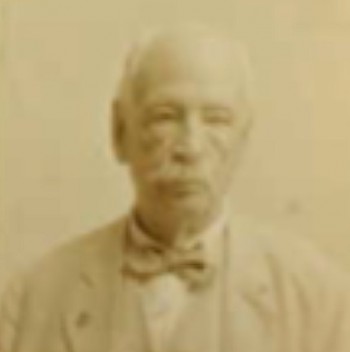
GREGORY, JAMES G. (1811-1865). Second lieutenant, 23rd Regiment, New York State National Guard, Company K. After he was commissioned as a second lieutenant in June 1863, he served 30 days in the 23rd Regiment and mustered out on July 22, 1863, at Brooklyn. Most likely, he was the father of Henry S. Gregory (see). Section 60, lot 717.

GRESHAM, JR., JAMES EDMUNDSON (1837-1892). First lieutenant, 38th Indiana Infantry, Company E. Of English origin, he was a Civil War veteran whose gravestone has an inscription indicating G.A.R. membership. He may have been the James Gresham who enlisted as a private on September 18, 1861, and mustered into the 38th Indiana. On May 5, 1865, he was commissioned as first lieutenant of his company and served in that rank until he mustered out on July 15, 1865, at Louisville, Kentucky. His last address was 154 22nd Street in Brooklyn. Section 135, lot 27263, grave 1330.
GRIBBEN, DAVID (1828-1890). Lieutenant colonel by brevet; major, United States Volunteers Paymaster’s Department; major paymaster, 21st New York Cavalry, Company A. Of Irish origin, he lived in Troy, New York, for many years. The census of 1860 indicates that he was living in Albany, New York, and was employed as a harness-maker. During the Civil War, Gribben was commissioned a major in the U.S. Volunteers Paymaster’s Department on October 20, 1864, and was promoted to major and additional paymaster that same day. On November 3, 1864, in his letter of acceptance, he wrote that he had been a resident of New York State for twenty-four years. He was promoted by brevet to lieutenant colonel “for faithful service” on November 1, 1865. On August 31, 1866, he was transferred into Company A of the 21st New York Cavalry as its major paymaster; that company was the last company from New York State to be mustered out of service. He honorably mustered out on June 1, 1869; his obituary in the Brooklyn Daily Eagle reports that he was the last paymaster as well as the last volunteer from New York State to leave the service after the end of the Civil War.
From 1871 until 1890, Gribben was variously listed in Brooklyn directories as a clerk, bookkeeper, and paymaster. His obituary reports that he was employed as the paymaster of the Atlantic Avenue Railroad Company in Brooklyn from the time the company was organized in 1872. In addition, he was active in the Freemasons where he had been a past master and belonged to the Independent Order of Odd Fellows. His last address was 314 Halsey Street in Brooklyn.
On July 31, 1996, Louise Smith, a resident of Wilton, Connecticut, whose family inherited the safe from the Gribben family, donated his paymaster’s safe, manufactured by Herring & Co. of New York, to the Smithsonian Institution. The paymaster’s safe, which is inscribed with Gribben’s name, tells the story of paymasters who rode to the field to pay the troops and whose detailed records were kept in such sturdy metal safes. The working lock mechanism uses two skeleton keys, one large and one small, and each is inscribed “6262,” to open the safe. Mrs. Smith was delighted that her family heirloom was “ending up in a place that will shine light on its historical significance.” The cause of Gribben’s death was cancer. Section 59, lot 1474, grave 93.
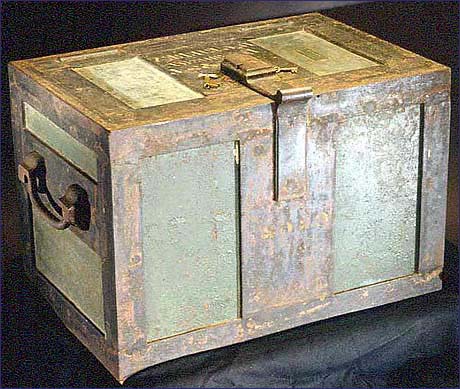
GRICE, JOSEPH B. (1835-1865). Second lieutenant, 3rd New York Cavalry; private, 5th New York Cavalry, Company L. A native of North Carolina, he enlisted as a private on September 12, 1861, and mustered into the 5th New York Cavalry on September 28. During his service, he was transferred to the 3rd New York Cavalry on November 24, 1862, at which time he was promoted to second lieutenant. He was dismissed on May 9, 1863. At the time of his death, caused by chronic diarrhea, he resided in Louisville, Kentucky. Section 115, lot 21092.
GRIFFIN, BRADNEY B. (1843-1872). Assistant surgeon, 1st New York Mounted Rifles; 4th New York Provisional Cavalry. A New Yorker by birth, Griffin was an 1861 graduate of Bellevue Hospital Medical College. During the Civil War, he enlisted as an assistant surgeon on April 8, 1863, at Suffolk, Virginia, and mustered into the 1st New York Mounted Rifles. A letter that he wrote to his father was part of an exhibit at the New-York Historical Society, “Pray for Me: Letters and Diaries from American Wars, 1858-1965.” Joyce Jensen excerpted part of his letter in an article about the exhibit that was published in The New York Times on November 12, 2000. The letter was written in 1863 after a raid on Charles City, Virginia:
We lost two men killed, one officer and four men wounded. Dr. Bennett had a ball through his overcoat. We captured every officer and man: 2 captains, 4 lieutenants, 1 surgeon and nearly 100 men. Horses, mules, arms, ammunition, everything fell into our hands. Among the prisoners was a female soldier, a woman of about 20 years. She had male attire, and used her rifle against us, as well as the rest. She has been in several engagements, Bull Run, Chancellorsville, etc.
He transferred into the 4th New York Provisional Cavalry’s Field and Staff on September 6, 1865, a regiment formed by the consolidation of the 1st Mounted Rifles that July, and resigned on September 25 at City Point, Virginia. The 1867 and 1872 New York City Directories list Griffin as a physician. He last lived at 319 West 22nd Street in New York City. His death was caused by apoplexy. His widow received a pension in 1875, certificate 177,622. Section 54, lot 7019.
GRIFFIN, DANIEL (1834-1873). Private, 131st New York Infantry, Company B. Originally from Ireland, Griffin enlisted at New York City as a private on July 27, 1862, mustered into the 131st New York on September 6, and deserted nine days later at Laurel Station, Maryland. He last lived at 24 West Washington Square in Manhattan. He died from phthisis. Section 17, lot 17245, grave 368.
GRIFFIN, WILLIAM WIRT (1838-1915). Rank unknown, United States Paymaster’s Department. Originally from Baltimore, Maryland, Griffin’s obituary in the Brooklyn Daily Eagle notes that both of his parents were members of the Eastern Shore of Maryland families. That obituary and his obituary in The New York Times state that he was attached to the Paymaster’s Department throughout the Civil War. His obituary in the Brooklyn Daily Eagle reports that he was a retired lieutenant in the United States Navy, having retired many years before his death due to impaired health. Griffin was a member of the Plymouth Church in Brooklyn where he lived the last thirty years of his life. He died of paralysis after a brief illness. He last lived at 808 Eighth Avenue in Brooklyn. He was interred at Green-Wood for eight years; on August 8, 1923, his remains were removed to Evergreen Cemetery.
GRIFFITH, ROBERT (1837-1877). Private, 72nd New York Infantry, Company G. A native of Ireland, he enlisted as a private on July 17, 1862, at Westfield, New York. On July 23, he mustered into the 72nd New York’s Company G. He served the duration of the Civil War and mustered out on May 15, 1865, at Elmira, New York. He died of phthisis at his residence, 14 East 54th Street, Manhattan. Section 183, lot 19141.
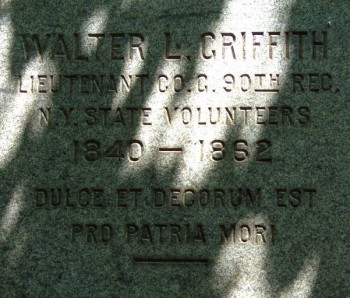
GRIFFITH, WALTER L. (1840-1862). First lieutenant and adjutant, 90th New York Infantry, Company G. After enlisting as a second lieutenant at Brooklyn on September 30, 1861, he mustered in on December 2, and was commissioned into his company on January 13, 1862. Promoted to first lieutenant and adjutant on August 16, 1862, he died of yellow fever on October 1, 1862, at Key West, Florida. Interment at Green-Wood was on March 5, 1864. Section 49, lot 8372.
GRIFFITHS, ALFRED W. J. (1839-1895). Private, United States Army. Born in London, England, he enlisted as a private in the U.S. Regular Army in January 1864 but was not assigned to a company. His enlistment record states that he was a laborer with gray eyes, brown hair and a fair complexion. He was discharged in February 1864. New York City Directories for 1873, 1876, and 1894 indicate that he was a bookkeeper. He last resided at 317 10th Street in Brooklyn. Section 135, lot 14964, grave 335.
GRIFFITHS, HARRY B. (1822-1866). Private 102nd New York Infantry, Companies K and E. A native of England, Griffiths enlisted as a private at New York City on March 25, 1862, and mustered into Company K of the 102nd New York four days later. In 1863, he had an intra-regimental transfer to Company E. His last residence was 132 Thompson Street in Manhattan. He died from sunstroke. Section 117, lot 10975, grave 1076.


GRIFFITHS, WALTER B. (1839-1908). Acting gunner, United States Navy. Of English origin, he served as an acting gunner in the United States Navy. As per the Navy Register, he enlisted as an acting gunner on December 13, 1862, and resigned on August 19, 1864. During his service, he served in the Atlantic Squadron on the USS Underwriter, USS Vermont, USS Portsmouth, USS Philadelphia, USS Colorado, USS Roanoke, USS Saratoga, USS Pennsylvania, and USS Valparaiso. The 1890 Veterans Census, which confirms his Civil War service, notes that he served under Admiral John A. Dahlgren on the USS Philadelphia from 1861 through 1864.
The census of 1880 and New York City Directory of 1884 indicate that Griffiths was working as a travel agent; as per the census of 1889, he was a clerk. He last lived in Honolulu, Hawaii. “Stomach trouble” was listed as the cause of his death. Isabelle Griffiths, who is interred with him, applied for and received a widow’s pension in 1911, certificate 761,637. Section 42, lot 11085, grave 12.

GRIFFITHS, WILLIAM E. (1842-1905). Rank unknown, United States Navy. According to his obituary in The New York Times, Griffiths, a native of New York City, served on the frigate Colorado during the Civil War. Other details of his service are unknown. A graduate of the College of Physicians and Surgeons in 1868, Griffiths continued his studies in Germany and was there at the start of the Franco-Prussian War in 1870 at which time he volunteered for the ambulance service of the Bavarian Army.
Griffiths practiced medicine for 30 years in Brooklyn, was a visiting surgeon affiliated with St. Mary’s Hospital, and at one time, worked for the Board of Health. He belonged to several medical societies, was president of the Third Ward Republican Club and was a member of the Brooklyn Young Republican Club. A member of U. S. Grant Post #327 of the G.A.R., he last lived at 320 Schermerhorn Street in Brooklyn. Nephritis caused his death. Section 57, lot 9191.
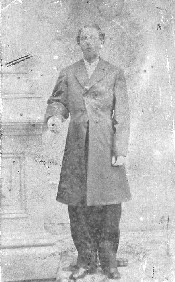
GRIGGS, CHARLES THOMAS (or THOMAS C.) (1843-1898). Private, 5th Virginia Cavalry, Company I; 15th Virginia Cavalry, Companies I and K, Confederate States of America. After enlisting as a private at Lynnhaven Beach, Virginia, on April 20, 1861, Griggs, a native of Princess Anne County in that state, mustered into the 5th Virginia Cavalry, Confederate States of America. He transferred into the 15th Virginia Cavalry, Company I, on May 2, 1862, and was transferred intra-regimentally to Company K at some point. (The 15th Virginia Cavalry was formed in September 1862 by consolidation of the 14th and 15th Battalions. In 1864, the 5th Cavalry was consolidated into the 15th Cavalry.) He was taken as a prisoner of war on September 23 or 24, 1864, at Strasburg, Virginia, sent to Point Lookout, Maryland, six days later, and arrived at Harpers Ferry, West Virginia, on October 3. The prisoner roll at Harpers Ferry listed him as exchanged on February 13, 1865. Griggs was paroled on April 21, 1865, at the District of Eastern Virginia in accordance with the terms of the surrender on April 9, 1865.
Griggs moved with his family to Brooklyn around 1870 and lived there until his death from “la grippe.” According to the census of 1880 and the New York City Directory of 1882, he was a railroad conductor; the New York City Directory of 1886 and the Brooklyn Directory of 1890 state that he was a watchman. His Civil War service is confirmed by the Veterans Census of 1890. He last lived at 46 Powell Street in Brooklyn. Section 154, lot 21859, grave 3.

GRIMM, CHRISTIAN (1846-1875). Sergeant, 62nd New York Infantry, Company F. A New Yorker by birth, he enlisted as a private at New York City on June 14, 1861, and mustered in on July 3. He re-enlisted on February 5, 1864, and was wounded at Petersburg, Virginia, on June 19, 1864. At some point during his service, he was promoted to sergeant. He mustered out on August 30, 1865, at Fort Schuyler, New York Harbor. After the War, he was a member of Riker Post #62 of the G.A.R. His last residence was on East 9th Street in Manhattan. Section 115, lot 13536 (Soldiers’ Lot), grave 119.
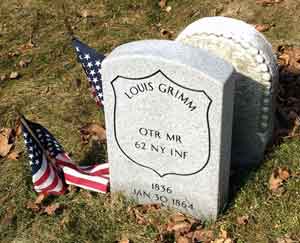
GRIMM, LOUIS (1836-1864). Quartermaster, 62nd New York Infantry, Companies H and F. He enlisted as a second lieutenant on April 27, 1861, at New York City, and on June 30, was commissioned into Company H of the 62nd New York and immediately transferred to Company F. On May 22, 1862, he was promoted to first lieutenant and two months later on July 21, his rank was raised to quartermaster. He was transferred from Company F to the Field and Staff on October 19, 1862, and died of consumption at New York City on January 30, 1864. He last lived on 4th Street in Manhattan. Section 115, lot 13536 (Soldiers’ Lot), grave 1.
GRINNELL, CORNELIUS (1826-1869). First lieutenant and adjutant, 39th New York Infantry. A native of New York City, he was well-known in the mercantile business where he worked in his father’s firm, Grinnell, Minturn & Co. During the Civil War, he enlisted at New York City as a first lieutenant and adjutant on May 28, 1861, mustered into the 39th New York that day but was not commissioned, and was discharged on an unknown date. He spent the last ten years of his life in London, England, where he founded and led a well-known firm, Grinnell & Co. Renowned for his business acumen, he was president of a fleet of packets traveling from New York to Liverpool, England, vice president of the London and Liverpool Insurance Company, and a director of the Atlantic Insurance Company in New York City. A boating enthusiast, his yacht, the Hawk, won several regattas and was considered one of the fastest yachts in England.
He last lived in London. As per articles in the Evening Post and the Albany Argus (New York) on August 13, 1869, Grinnell died after losing his balance and falling off a balcony at Walmer, a seashore on the Isle of Wight in England, where he had gone in hopes of restoring his health. The coroner at Ryde, England, determined that he was not drunk and the death was an accident. The Evening Post noted that he “…was honorable and just in all of his commercial dealings, public-spirited and generous by nature and habit, acknowledging the obligations and practicing the habits of a Christian gentleman.…” On September 1, 1869, the New York Herald reported on his funeral at Trinity Church in Manhattan. About 2,000 people were in attendance including many from the business, banking and insurance industries. The article noted that the unpretentious Episcopal service had no pall bearers and that there were only two females, distant cousins, present. A cortege of twenty carriages brought the body to Green-Wood where Grinnell was buried in the family’s vault in a sorrowful stillness. Section 75, lot 2146.
GRISWOLD, HENRY A. (1834-1864). Private, 151st New York Infantry, Company H. A native New Yorker, Griswold was a lawyer as per the census of 1850 and the 1857 New York City Directory. During the Civil War, he enlisted as a private on January 13, 1864, at New York City where he resided, and mustered into the 151st New York that day. He was wounded in the arm at Cold Harbor, Virginia, on June 3, 1864. The injury necessitated amputation and he died on June 24, 1864, in Philadelphia, Pennsylvania, from results of the wound and typhoid fever. His funeral was held at his brother’s home in Harlem. Section 182, lot 15885.
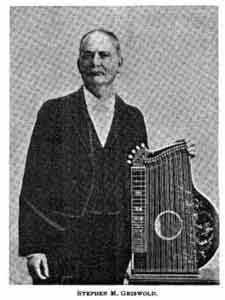
GRISWOLD, STEPHEN M. (1836-1916). Born in Windsor, Connecticut, Griswold grew up on a farm there, and moved to Brooklyn at fifteen where he was initially employed in a grocery store. He then became a salesman at a jewelry store on Maiden Lane in Manhattan and subsequently opened his own jewelry store. In 1851, he joined the Plymouth Church in Brooklyn and formed a close relationship with the Reverend Henry Ward Beecher (see), the renowned leader of that congregation. He appears to have been a G.A.R. member, an organization of Civil War veterans, but this may have been an honorary position; no documentation of his service during the Civil War has been found. However, he did play a role when the American flag was raised at Fort Sumter on April 14, 1865, after General Robert E. Lee’s surrender.
As per an article in the Brooklyn Standard Union on April 13, 1904, when he spoke to the Review Club at Plymouth Church in Brooklyn, and another article in the Brooklyn Daily Eagle on April 13, 1909, when he addressed the Young Men’s Club at the same site, Griswold recalled the ceremonies at Fort Sumter, South Carolina, in April 1865. Griswold remembered that he, Reverend Henry War Beecher, and 180 other Brooklynites chartered the steamer Oceanus for $18,000, left home on April 10, 1865, and traveled to Charleston, South Carolina, to witness the event. Beecher, in a rousing oration to the crowd on April 13, 1865, told the African-Americans that they were free. Reverend Beecher was also the keynote speaker at noon on April 14, 1865, when the flag of the United States was raised above Fort Sumter. Griswold reminisced, “…there was the old flag floating in the breeze as it did four years before when peace reigned throughout the entire country….” The 1904 article reports that Griswold commented on the lamentable conditions in Charleston and showed relics that he had collected there including a Confederate flag. He also praised Major Robert Anderson who was present at the 1861 surrender of the fort and at the flag-raising four years later. Those present for the historic flag-raising formed an organization, the Sumter Club, which met once every year to celebrate that historic occasion.
After the Civil War, Griswold returned to his jewelry business. In 1867, he and his wife toured Europe and met Queen Victoria and her children. On that trip, he met up with a group of “pilgrims” heading for the Holy Land on the Quaker City steamer. One fellow passenger, the author Mark Twain, was hired to write articles about the journey that became the basis for Twain’s first best-seller, Innocents Abroad. The trip was considered the first trans-Atlantic cruise and the passengers were the inspiration for the characters in Twain’s novel. Mrs. Louise Griswold, who wasn’t happy with the portrayal of her husband in that book, wrote her own log of the trip, A Woman’s Pilgrimage to the Holy Land, which was published in 1872. As per his obituary in the Auburn Citizen, the Griswolds were entertained at the palace of the Tsar of Russia during their European journey. That obituary also noted that he was a friend of Mark Twain’s but Mrs. Griswold’s log, as noted, doesn’t confirm that friendship. In 1875, he was elected to the Board of Aldermen in Brooklyn, was re-elected in 1877, and became a State Senator in 1885. He became president of the Union Bank in Brooklyn in 1892, was chairman of Group of Seven of the New York State Bankers’ Association which comprised all banks in Brooklyn and Long Island and held the position of president of the State Association in 1908. His obituary in the Brooklyn Standard Union reports that he wrote Sixty Years with Plymouth Church in 1907, having served as right aisle usher throughout his membership. He last lived at 787 Carroll Street in Brooklyn. His death was caused by apoplexy. Section 112, lot 13241.
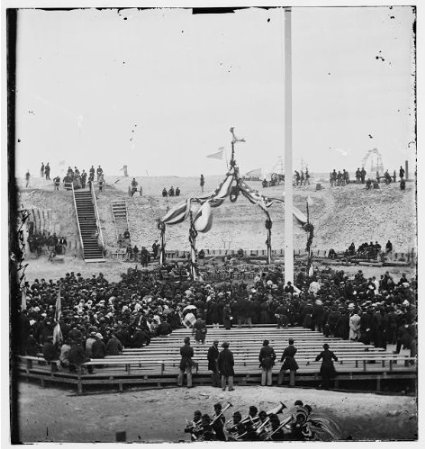
GROODY, JOHN (1830-1874). Sergeant, 1st New York Engineers, Company C. Groody was born in New York City. On July 18, 1858, he married Sarah Jane Vanwinkle there; the couple had four sons. As per the 1860 census, he lived in Manhattan with his wife, worked as an engineer and had a personal worth of $250.
During the Civil War, he enlisted on January 15, 1862, as a private at New York City, mustering into his company the same day. According to his enlistment papers, he was a carpenter who was 5′ 7″ tall with grey eyes, brown hair and a light complexion. His paperwork notes that he was absent and detailed to the Engineer Department from January through March of 1863. He rose through the ranks becoming a corporal on June 1, 1864. On September 22, 1864, his captain requested that he be granted a furlough as a reward for “uniform attention to his duties, during the past two and a half years.” His furlough for 30 days was spent in New York City. Groody was promoted to sergeant on November 1, 1864. He mustered out on January 14, 1865, at Hilton Head, South Carolina. At the time of muster out, he was due a bounty of $100, a clothing account balance of $10.35, and traveling expenses; his paperwork shows time spent Florida and South Carolina.
As per the 1874 New York City Directory, he was a carpenter. He last lived at 415 West 48th Street in Manhattan. The 1876-1878, 1882-1883, 1885-1886 and 1891-1892 New York City Directories list Sarah Groody as John’s widow; as per the 1876-1878 Directory, she did sewing to earn money. In 1885, Sarah Groody applied for and received a widow’s pension, certificate 233,168. Section 153, lot 19440.
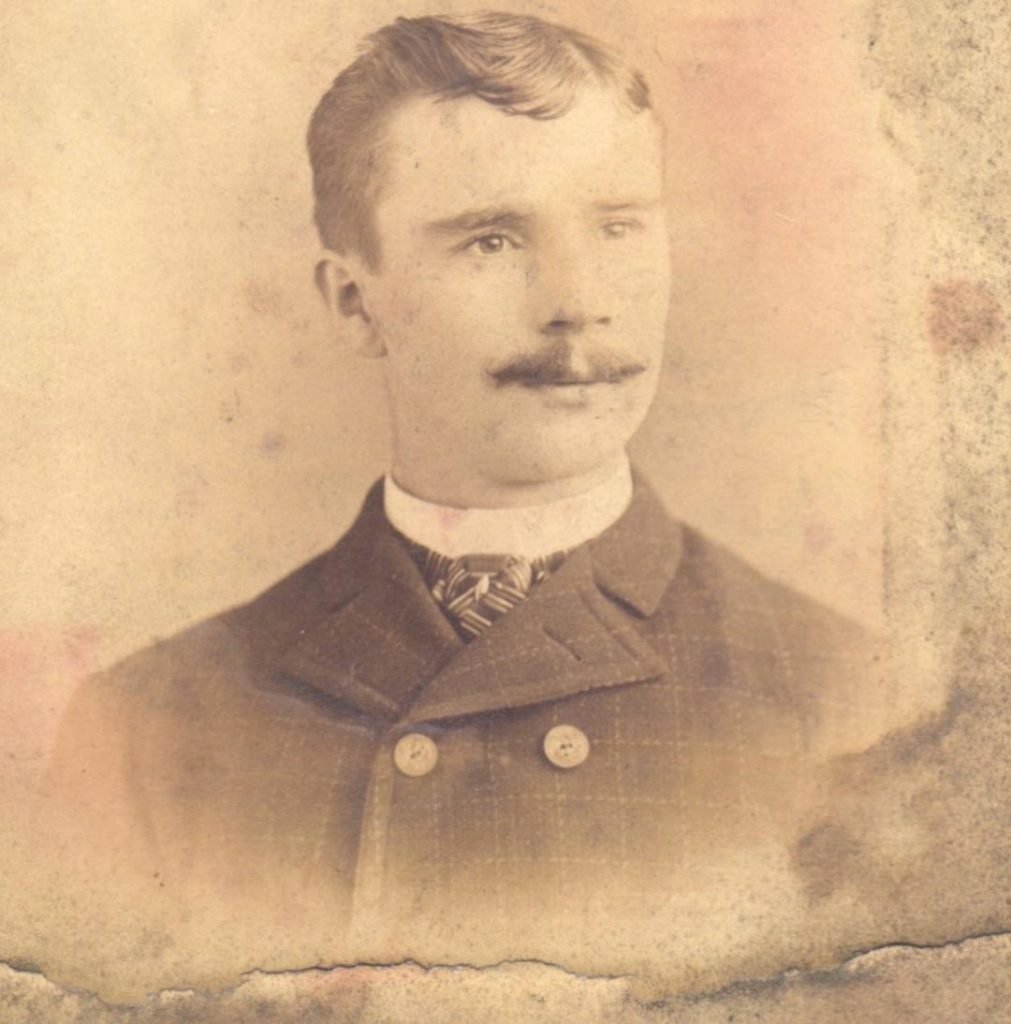
GROOME (or GROOMS), JAMES W. (1837-1866). Private, 30th New York Infantry, Company G; 76th New York Infantry, Companies C and A; 147th New York Infantry, Company A. A native of New York State, Groome served in three New York regiments after he enlisted on September 3, 1862, at Saratoga Springs, New York, as a private. He mustered into the 30th New York on October 9, was transferred into Company C of the 76th New York on May 25, 1863, and was later transferred intra-regimentally to Company A on November 8, 1864. On January 28, 1865, he was transferred into the 147th New York from which he was discharged. Groome last resided in St. Paul, Minnesota, where he died from consumption. Section 182, lot 10511.
GROSER (or GROCER, GROSSER, GRESER), THOMAS W. (1841-1883). Corporal, 48th New York Infantry, Companies B and C. As per his online family tree,Groser wasborn in Connecticut, circa 1841, to Thomas and Frances Jones Groser. Groser’s death certificate notes that Thomas’s father was born in the West Indies and his mother was born in Connecticut, information verified by several censuses. A younger brother, Charles, was born in 1847, and a sister, Emily, was born in 1849, the same year that his mother died. At the time of his mother’s death, the family lived in Brooklyn. His father remarried and Thomas had four half-siblings: Mary (born 1852); Samuel (1857); Charlotte (1860); and Herbert (1862). All of his siblings were born in Brooklyn. The 1855 New York State census, which records the family name as Grocer, lists Thomas as a fifteen-year-old. His father’s second wife is named Mary, age 28, and there are seven children living in the home with the surname Grocer, including Thomas, Charles and Emily. Half-sibling Mary is listed as an infant and four of the children’s ages and names do not match the information on the online family tree. As per the 1862 Brooklyn Directory, Groser was a machinist living at 80 Duffield Street.
According to his muster roll, which lists him as Thomas Grocer, he enlisted as a private at Brooklyn on September 5, 1861, and mustered into Company B of the 48th New York three days later. Upon his promotion to corporal on September 21, 1863, he was transferred to Company C. On February 20, 1864, he was wounded at Olustee, Florida. Groser mustered out on March 3, 1864. The New York Report of the Adjutant-General, which lists his casualty and injury in the line of duty, incorrectly indicates next to “Survived War?-No.” As per an entry on the Internal Revenue Service Tax Assessment Lists, Thomas W. Groser of 109 Ainslee Street is reported as having an income of $1,105 and owning a watch.
The 1865 New York State census reports that Groser was living in Brooklyn with his father, step-mother, Charles, Emily, and half-siblings Samuel, Charlotte and Herbert. Mary is not listed but Ali Groser, age 23, relationship unknown, is living with the family. The 1867 Trow’s Business Directory lists Thomas Groser at 57 Front Street in New York City. The 1870 census, which spells the family name as “Grosser,” reports that Thomas was living in Williamsburg, working as a clerk, and was a “male citizen over 21.” That census states that his father and step-mother were foreign born. There are seven other children with the last name of Grosser; only Mary, 18, is a name and age match. As per the 1873 Brooklyn Directory, Groser is a carman living at 39 Fleet Street in Brooklyn. The 1878 Brooklyn Directory identifies him as a bookkeeper living at 109 Ainslie Street.
According to the 1880 census, he was living at 226 Broadway in Brooklyn with his cousin, Charlotte Groser, and a niece and two nephews who bore the surname “Denyse.” Thomas, who was named as the head of the household, was single, worked as a clerk in a law office and was listed as semi-deaf and “deaf and dumb.” That census states that Thomas’s father was born in Jamaica. The 1883 Brooklyn Directory only lists 104 South 5th Street as Groser’s address; no occupation is given. Groser’s death certificate, which spells the surname “Greser” indicates that he last lived at 190 Ainslee Street, worked as a law clerk, died from phthisis pulmonalis (paralysis of the lungs), and was 42 years old when he died. Section 63, lot 2217.
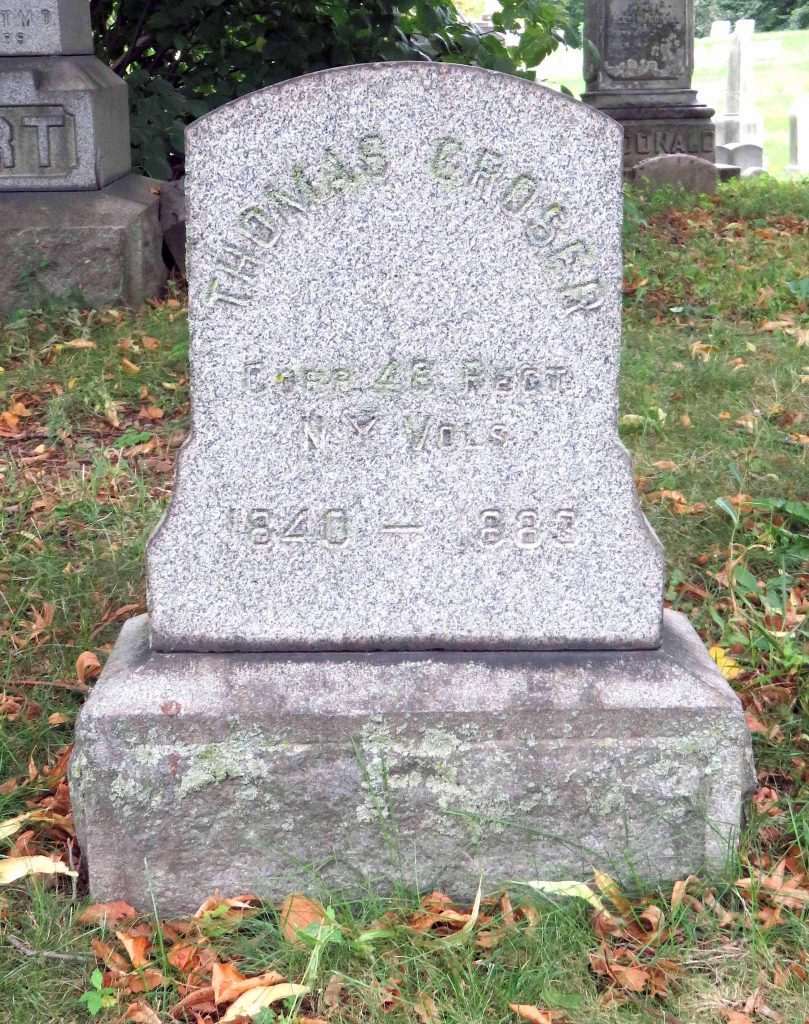

GROSS, JOHN (1823-1891). Private, 174th New York Infantry, Company K. A native of Germany, Gross enlisted at New York City as a private on September 24, 1862, and mustered into the 174th New York on November 6. Listed as sick at New Orleans, Louisiana, on October 31, 1863, he was absent and sick when his company mustered out there on February 17, 1864. His last residence was in Jersey City, New Jersey. His death was attributed to gastric fever and “old age.” Section 180, lot 12602.
GROSS (or GROS), RUDOLPH (1822-1873). Private, 5th Regiment, New York State Militia; 11th Regiment, New York State National Guard, Company F. A native of Switzerland, Gross enlisted as a private in 1861 and served three months with the 5th New York State Militia, from May 1 until August 7 when he mustered out with the regiment at New York City. He re-enlisted as a private at New York City on May 28, 1862, and immediately mustered into Company F of the 11th Regiment. He mustered out with his company after three months on September 16 at New York City. Section 64, lot 4071, grave 153.

GROTHEER, JOHN H. (1830-1883). Private, 1st South Carolina Infantry; 1st Regiment, South Carolina Militia Artillery, Confederate States of America. Grotheer, a native of New York, is the only soldier with that name on Civil War records. He served with two Confederate regiments. He first served with the 1st South Carolina Infantry but the details of that enlistment, including the company assigned, are unknown. He subsequently re-enlisted and joined the 1st South Carolina Militia Artillery, but there are no further details about that service.
The Charleston, South Carolina Directory for 1869 lists him as a grocer; the census of 1870 indicates that he was living in Jamaica, Queens, and working as a house painter. According to the Brooklyn Daily Eagle, he served as a watchman at the Truant Home in Brooklyn where he was dismissed for intoxication. His last residence was on Smith Avenue in East New York, Brooklyn. Section 13, lot 8792.
GROUT, THOMAS JEFFERSON (1832-1913). Private, 7th Regiment, New York State National Guard, Company A. Grout, a New York City native, attended public school and was a graduate of the College of the City of New York, class of 1853. As per his obituary in The New York Times, which confirms his Civil War service, he taught public school for one year at a school on 9th Street and First Avenue. The census of 1860 notes that he was a grain measurer. During the Civil War, he enlisted as a private on May 25, 1861, at New York City, mustered into the 7th Regiment but was dropped and did not serve. A year later, he served with the 7th Regiment, New York State National Guard, for its three month activation.
According to the census of 1870, he was a weigher who owned real estate worth $3,800, and a personal estate of $500. The 1880 census reports that he was a weigher; the census of 1900 states that he was a grain inspector. Grout’s obituary reports that he was an active worker in the Baptist Church for 50 years, and was a member of the New York Produce Exchange. His last residence was at 415 West 146th Street in Manhattan. His death was attributed to heart disease. Section 28, lot 10440.
GROVE, FRANCIS H. (1828-1912). Acting master, United States Navy. Born in England, he joined the Navy as an acting master on January 22, 1862. In October 1863, the USS Commodore and the USS Corypheus, on which Grove served, destroyed a Confederate tannery at Bay St. Louis, Mississippi. Grove wrote that they had “completely destroyed the buildings, vats, and mill for grinding bark; also a large amount of hides stored there, said to be worth $20,000.” As per his obituary in The New York Times, he served with Admiral David Farragut during the Civil War. He was honorably discharged on November 23, 1865.
In civilian life, Grove was the manager of the Croton Water Company, which supplied drinking water to New York City. He was awarded a pension from the Navy under certificate 23,101. Grove joined the G.A.R. Naval Post #516 in Brooklyn on November 28, 1885. His Civil War service is confirmed by the 1890 Veterans Schedule. His last residence was at the Sailors’ Home in Snug Harbor, Staten Island. In 1919, his wife applied for and received a widow’s pension, certificate 869,961. Section 196, lot 28154, grave 3.
GROVES, GEORGE (also enlisted as BOYLE, GEORGE) (1835-1907). Private, 30th Massachusetts Infantry, Company H. Groves’ birth place is unclear. The 1860 census, which records his name as George Boyle, notes that he was born in Scotland, was a ship carpenter, and lived in Brooklyn with his wife and infant son. However, his obituary in the Brooklyn Standard Union reports that he was born in Ireland. His soldier record indicates that he was resident of Dracut, Massachusetts, and a laborer by trade, when he enlisted as a private using the alias “George Boyle” on November 1, 1861. He mustered into the 30th Massachusetts on November 13, and mustered out on January 1, 1865.
According to his obituary in the Brooklyn Standard Union, which confirms his Civil War service, he had lived in Brooklyn for forty-five years and was a manufacturer of children’s shoes until his retirement in 1897. As per his pension index card, which lists George Boyle as his alias, Groves’s application for an invalid pension was approved in 1891, certificate 911,481. Groves was a member of the G.A.R., a Freemason, and member of St. Ann’s Protestant Episcopal Church. His obituary notes that he was buried with Grand Army and Masonic honors. He last lived at 459 Pacific Street in Brooklyn. His death was attributed to apoplexy. Annie Groves, who is interred with him, applied for and received a widow’s pension in 1908, certificate 642,481. Section 116, lot 15615, grave 369.

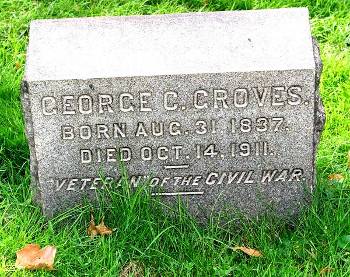
GROVES, GEORGE C. (1837-1911). Sergeant, General Mounted Service, United States Army. Born in Ireland, Groves immigrated to the United States with his family when he was a boy. He joined the General Mounted Service (Cavalry) of the U.S. Army on November 4, 1858. During the Civil War, he enlisted as a private at Boston, Massachusetts, on October 15, 1863, mustered that day into the U. S. Army General Service, and was promoted to sergeant on an unstated date.
On January 20, 1868, Groves was recommended for promotion to second lieutenant; the promotion was denied two days later on account of age; the denial read, “30 years of age-not eligible.” Groves, in his letter dated January 31, 1868, requesting the promotion, noted, “I have served in the Army as an enlisted man since 4th of November, 1858, and have been six years, and more, of that time as a non–commissioned Officer.” He listed the officers under whom he had served and asked that attention be addressed to “the endorsements accompanying this application.” Groves enclosed a document from the officers at Carlisle Barracks, Pennsylvania, dated January 20, 1868, which attested to his “general ability, attention to duty, and excellent deportment rendering him in our opinion a deserving candidate for appointment.” On January 31, 1868, William Grier, his colonel, wrote to Senator Simon Cameron of Pennsylvania, asking for his help to secure Groves’s promotion. Grier wrote:
He [Groves] has great faith that if you will ask of the Secretary of War of General Grant, their favorable consideration of his application, that it will be successful. May I ask your early attention of influence in behalf of this excellent Non Commissioned Officer.
On October 15, 1868, Groves left the military. According to the census of 1880, he was a clerk in a store. In 1895, his application for an invalid pension was approved, certificate 891,252. His last residence was at 1604 45th Street, Brooklyn. Groves’s gravestone identifies him as a “veteran” of the Civil War as does his obituary in the Brooklyn Standard Union. At the time of the 1910 census, he was living with his daughter. Shortly after his death from nephritis in 1911, Anne Groves, who is interred with him, applied for and received a widow’s pension, certificate 736,147. Section 87, lot 1715, grave 174.
GROVES, JOHN S. (1833-1873). Private, 84th New York (14th Brooklyn) Infantry. Of English origin, Groves enlisted as a private at Brooklyn on September 9, 1862, and mustered into an unknown company on that date. The place and date of his discharge are unknown. His last residence was in Parkville, New York. He succumbed to heart disease. Section 17, lot 17245, grave 1046.


GROWER, WILLIAM THOMAS CAMPBELL (1839-1864). Colonel, 17th New York Infantry, Company D. Born in England, he worked as a receiving bank teller at the Metropolitan Bank of New York. At the onset of the Civil War, he gave up his position at the bank when he enlisted as a captain of Company D of the 17th New York Infantry in May 1861. As per an article in The Sun on May 12, 1895, he learned chess from his father, James Grower, who was a devotee of the game. William T. C. Grower’s comrades remembered that he carried his chess pieces and board to the front.
Promoted to major on June 20, 1862, with rank from May 10 of the previous month, Grower was shot in the leg at the Battle of Second Bull Run, Virginia. He was discharged for disability in 1863 but his discharge was revoked a few weeks later. When the 17th reorganized in October 1863, he became colonel of the 17th New York Veteran Infantry and commanded the 3rd Brigade, 4th Division, 16th Army Corps of the Army of the Tennessee in the summer of 1864. Grower, in his early twenties at the time, was the youngest colonel in the United States Army. The 17th took part in General William T. Sherman’s expedition in Mississippi and Alabama and arrived in Atlanta, Georgia, in August 1864. The 17th was at the forefront at the assault on Jonesboro, Georgia, where a thousand Confederate prisoners were captured, but, Grower was gravely wounded there; he succumbed in Atlanta on September 3, 1864.
Two days after his death, Major Joel O. Martin of the 17th wrote at headquarters about Grower, “In him the Government has lost one of its bravest and noblest defenders, and the regiment its beloved commander…” Similarly, Brigadier General James D. Morgan, United States Army, in his field report from White Hall, Georgia, on September 9, 1864, noted that Grower fell at the head of his regiment in an engagement in which over 500 men were killed or wounded. Morgan reiterated the praise in his September 21 report, “In the short time he had been with the command he had endeared himself to all by his soldierly bearing…” Grower was interred at Green-Wood on September 21, 1864. A resolution by the officers of the 17th Regiment stated, “…in the death of Colonel Grower the Government has lost a young, accomplished, patriotic and brave defender…” On December 5, 1864, Sarah Grower applied for and received a widow’s pension, certificate 48,140.
On April 28, 1890, the Brooklyn Standard Union published an article, “War Incidents” which highlighted the “Sights in New York During the Long Struggle” and the sad fate of W. T. C. Grower. The article began with a remembrance of Broadway and the call for recruits:
Broadway, New York, in the early days of the Rebellion presented an enlivening sight. Barracks stood in the Park, with tents in various places, calling for volunteers. Officers and soldiers were seen on the streets, at the theatres, in hotel corridors, etc. Shop windows displayed pipes, haversacks, canteens, folding cups and camp comforts, while the music of a band or the noise of a drum was constantly heard. At the recruiting stations large banners hung across the thoroughfare inscribed: “On to Richmond!” “Ho! for Gen. Banks!” and “Those who shall rise up at their country’s call; their name is legion.” The departure of regiments amid hurrahs and the waving of handkerchiefs, had, from time to time, caused the sidewalks to be thronged….”
The author of the article remembered that the War fever subsided, the Draft was instituted with ensuing riots in July 1863, and regiments were returning home. The article continued:
During this dark period, I well remembered, when a boy at school, seeing a banner, perhaps the only one at the time, suspended across Broadway near Spring Street, inscribed: “How to avoid the draft; join the Seventeenth Regiment. Col. W. T. C. Grower.” Nearly a year had passed, when one noon of a bright sunny day the Seventh Regiment, marching to the solemn strains of a dirge, were seen coming down Wall Street. In the centre of the column a hearse carried a silver mounted casket enwrapped in an American flag. Who could it be? When the daily paper, answering my query, caused a quiver to run through my entire frame at the simple announcement—Col. W. T. C. Grower, killed in the attack on Jonesboro, Ga. It seemed but the day before that the name had fluttered on the breeze on Broadway. He had fallen in battle. A curiosity had seized hold of me; I must learn all the circumstances….
The author related Colonel Grower’s wartime service, death and return to New York City after he had fallen:
The body was sent to New York where, as already stated, it was received by the Seventh Regiment and conveyed to the City Hall in this city, where it lay in state the entire day with the flags at half mast, and drawing many visitors, with Company G, Thirteenth Regiment, acting as a guard of honor. It was on Wednesday afternoon, Sept. 21, 1864, that the funeral services took place from his father’s residence, on Jefferson Street near Bedford Avenue, the house being filled with citizens and military…At the close of the services the funeral procession was formed, headed by a police force under Sergeants Wright and Smith. Then followed the Thirteenth Regiment, under command of Col. Woodward [see], and a large number of carriages, the first bearing a young widow with two beautiful children, all clad in heavy mourning, all of whom proceeded to Green-Wood Cemetery, where the final shots were fired over the grave. Of Col. Grower it was said: “He was born to command, esteemed by his superiors for his soldierly bearing and manly qualities, beloved by his officers and adored by his men. He was a patriot, a soldier, a Christian.”
Section 98, lot 15301.
GRUBER, ABEL (1844-1896). Corporal, 7th New Jersey Infantry, Companies K and C. Gruber, a clerk, 5′ 4″ with gray eyes, fair complexion and light colored hair, enlisted together with his brother John (see), as a private on September 15, 1861, at Trenton, New Jersey, and mustered into Company K of the 7th New Jersey on October 2. He received gunshot wounds to his hand and right thigh just above the knee on July 2, 1863, at the Battle of Gettysburg, Pennsylvania, and was taken as a prisoner of war on the field. He was paroled the next day and treated at the field hospital at Gettysburg. Four days later, he was sent to Newark, New Jersey, where he remained at the hospital for treatment for five or six months. He returned to his regiment on January 3, 1864, and was promoted to corporal on February 1, 1864. He was transferred to Company C on October 1, 1864. At some point, he was taken as a prisoner of war and confined to Andersonville Prison in Georgia for five months. This is confirmed by the Andersonville Database and the Veterans Schedule of 1890. He was discharged on January 10, 1865, at Camp Parole in Annapolis, Maryland.
As per the census of 1870, Gruber had a stand in a market; the census of 1880 indicates that he was a butter dealer. In 1880, his application for an invalid pension was granted, certificate 218,641. The 1891 New York City Directory reports that he was in the butter business. He last lived at 323 Carlton Avenue in Brooklyn. His cause of death was cancer. Section 190, lot 18050, grave 6.
GRUBER, JOHN J. (1840-1865). Private, 7th New Jersey Infantry, Company K; 5th United States Artillery, Company B. Born in Philadelphia, Pennsylvania, Gruber was 5′ 4½” tall with light hair and a fair complexion and helped support his parents. He enlisted with his brother Abel (see) on September 15, 1861, and mustered into the 7th New Jersey, Company K, on October 2 of that year. In March 1862, he caught a cold that led to a hemorrhage of the lungs resulting in hospitalization at Yorktown, Virginia. He also served in Company C of the regiment. Among the actions that he participated in Virginia were: the Siege of Yorktown, the Battles of Williamsburg, Seven Pines, Oak Grove, Savage Station, Glendale, Malvern Hill, and Harrison’s Landing. He then was part of Pope’s Campaign in Northern Virginia where he saw action at the Battles of Bristoe Station, Groveton, Bull Run, and Chantilly. After protecting the defenses at Washington, D.C., until November 1, 1862, he was sent to Falmouth, Virginia, then fought at the Battle of Fredericksburg and was at the Mud March in January, 1863, before returning to operations at Rappahannock Bridge.
On February 2, 1863, he was discharged at Fort Hamilton, Brooklyn, and mustered into the Regular Army three days later. He died of consumption that he contracted while in the military on December 31, 1865, at his residence in Manhattan at 288 West 51st Street. His mother, Hester Gruber, applied for and received a pension, certificate 193,659. Section B, lot 9895, grave 315.

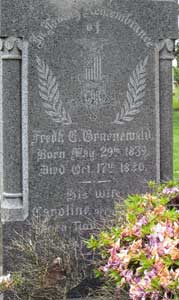
GRUENEWALD, FRIEDRICH (or FREDERICK) E. (1839-1880). Private, 2nd Missouri Light Artillery, Battery B. A New York City native, he may have been the Friedrich Gruenewald who enlisted as a private and mustered into the 2nd Missouri Light Artillery. Further details about his service are unknown. After the War, he belonged to the G.A.R., a membership that was prominently inscribed on his tombstone. As per the census of 1870, he was a wood carver; the census of 1880 and the New York City Directory of 1880 report that he had a crockery store. His last residence was 20 Avenue A in Manhattan. He died of pneumonia. Section 187, lot 19489.
GUNNING (or GUNING), MICHAEL T. (1846-1869). Private, 103rd New York Infantry, Companies A and D. Born in the Bronx, Gunning enlisted as a private at New York City on December 18, 1861, and mustered immediately into Company A of the 103rd New York. He was transferred into Company D the next day. At some point during his service, he was confined to Fort Royal, South Carolina, and was absent when his company mustered out on December 7, 1865, at City Point, Virginia. He last resided in Leavenworth, Kansas, where he died after being shot. Section 94, lot 882.
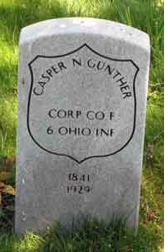
GUNTHER, CASPER N. (1841-1929). Corporal, 6th Ohio Infantry, Company F. Of German birth, Gunther enlisted as a corporal on April 20, 1861, mustered into the 6th Ohio on that date, served for three months, and mustered out on June 18. On that day, he re-enlisted and mustered into the same regiment as a private, and was discharged for disability on April 12, 1863, at Murfreesboro, Tennessee.
On March 5, 1877, an article in the New York Herald which was headlined “A Safe Investment” reported that Gunther’s jewelry store was burglarized. The thieves broke into his safe and stole $5,000 worth of jewelry. The article noted that valuable silverware was left undisturbed in a nearby showcase. He applied for and was granted an invalid pension in 1883, certificate 1,084,277. The Brooklyn Directory for 1890 and the censuses of 1900 and 1910 report that he was a jeweler. His last residence was 34 Parker Avenue in Manasquan, New Jersey. Section 136, lot 28307, grave 743.



GUNTHER, GEORGE (1844-1907). Private, 27th Connecticut Infantry, Company K; Veteran Reserve Corps, 2nd Company; 9th New Jersey Infantry, Company E. A native of Germany and a woodcarver by trade, Gunther was 5′ 7″ tall with sandy hair, blue eyes and light complexion. He enlisted on September 10, 1862, and mustered into the 27th Connecticut Infantry on October 18. He was wounded in the head on December 13, 1862, at Fredericksburg, Virginia, and taken to the field hospital. On December 31, he was sent to Knight General Hospital at New Haven, Connecticut, where he remained until July 20, 1863, when he was transferred into the Veteran Reserve Corps, 2nd Company, First Battalion. He was discharged five days later at Hartford, Connecticut. On September 29, 1864, he re-enlisted as a private, mustered into Company E of the 9th New Jersey as a substitute, and mustered out on June 14, 1865.
The 1870 census reports that Gunther was a carver. In 1873, his application for an invalid pension was granted under certificate 129,545. The Brooklyn Directory for 1887 lists Gunther as a carver. As per his obituary in the Brooklyn Daily Eagle, he was a member of the Brooklyn Saengerbund, a German choral society, the Ulysses S. Grant Post #327 of the G.A.R., and was secretary of the Prudential League; members of those groups were invited to attend his funeral. He last lived at 296 Baltic Street, Brooklyn. His death was caused by apoplexy. Alma Gunther was the guardian for their son Herbert who received a minor’s pension in 1908, certificate 669,406; Alma Gunther, who is interred with him, received a widow’s pension in 1917, certificate 851,713. Section 199, lot 28742, grave 2.

GURLITZ, AUGUSTUS TRAUGOTT (1842-1928). First lieutenant, 2nd Kentucky Cavalry, Company H. As per his obituary in The New York Times, Gurlitz was born in Riga, Latvia, and immigrated with his parents to the United States in 1850, at which time his father purchased a large cattle ranch near San Antonio, Texas. During the Civil War, Gurlitz helped raise Kentucky Union troops which became Company H of the 2nd Kentucky Cavalry. Gurlitz joined that company as a sergeant in 1861, and, at some point, was promoted to first lieutenant of the color company. The obituary notes that Gurlitz was in twenty-one battles, more than one hundred engagements and was wounded on several occasions.
After the Civil War, Gurlitz settled in New York City where he graduated from Columbia Law School and was admitted to the New York State Bar in 1870. For over fifty years, he was a prominent attorney who specialized in copyright, patent and trademark law. Among his well-known clients were Arthur Conan Doyle, General Lew Wallace, and Rudyard Kipling. His application for an invalid pension in 1907 was successful, certificate 1,130,500. His obituaries in The New York Times and in the Brooklyn Standard Union report that he was the advocate general for the G.A.R., Department of New York, for two years. Active in many organizations, he was a member of the New York State and National Bar Associations, the Columbia Law School Alumni Association, the Army and Navy Organization and the Military Order of the Loyal Legion, a patriotic association. He last lived at 109 Clark Street in Brooklyn.
Recently, the Antiquarian Booksellers’ Association of America offered a letter and original envelope signed by Samuel Clemens (Mark Twain) to Gurlitz, postmarked December 3, 1900, asking for Gurlitz’s help in assisting his friend, Rudyard Kipling, whose work Outward Bound came out in a pirated edition by Fenno, an American publisher, in competition with Scribner’s authorized edition. The asking price of the letter was $5,000. Section 95, lot 947.
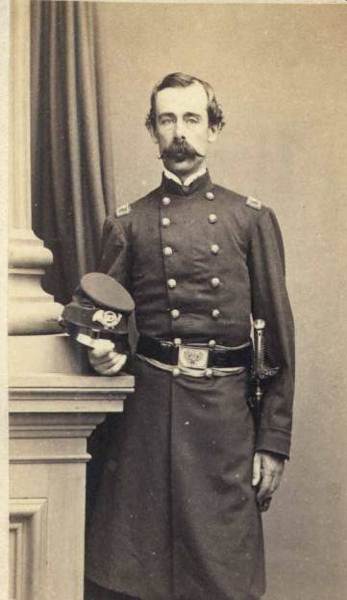
GURNEY, WILLIAM (1821-1879). Brigadier general by brevet; colonel, 127th New York Infantry; captain, 65th New York Infantry, Company C; first lieutenant, 7th Regiment, New York State Militia, Company D. Born in Flushing, New York, Gurney was a wholesale grocer and commission merchant before he enlisted as a first lieutenant on April 17, 1861, and mustered into the 7th Regiment on April 26. He mustered out on June 3, 1861, was promoted to captain on June 18 effective upon being commissioned into the 65th New York, known as the “Fighting Chasseurs,” on July 11. He served with the Army of the Potomac during the Peninsula Campaign in 1862. According to one source, he was then appointed assistant inspector general and examining officer on the staff of Governor Morgan and given authority to raise a regiment that July, an assignment that he completed in 30 days. Discharged for promotion on August 21, 1862, he was appointed colonel of the 127th New York, the regiment that he raised, effective September 1, and served at Norfolk, Virginia. From April 11 to May 4, 1863, he led the 127th during the siege and defense of Suffolk, Virginia.
After the Battle of Gettysburg, Pennsylvania, Gurney returned to the Army of the Potomac and then was with the Department of the South. On March 29, 1864, he led a detachment of the 127th at the skirmish at Bull’s Island, South Carolina. He commanded the 127th at the engagement at Honey Hill, South Carolina, on November 30, 1864, and was wounded at the Battle of Deveaux’s Neck, South Carolina, the next month on December 6. Brigadier General Edward B. Potter, United States Army, thanked Gurney in his field report of December 11, 1864, citing his character and tenacity under heavy fire, a concealed enemy and difficult circumstances that prevented success. He was wounded at Pocotaligo Bridge, South Carolina, in December 1864, and put in command of Charleston after its capture. Gurney was promoted to brigadier general by brevet on May 19, 1865, “for meritorious services during the War.” This, however, did not sit well with Colonel Henry M. Hoyt of the 52nd Pennsylvania Infantry, who in his application for a brevet wrote that he should receive one “because a Brevet Brig. Gen. has been conferred upon Col. Gurney, 127th N.Y. Volunteers who was the sole cause of our disaster at Fort Johnson, 3 July 1864.”
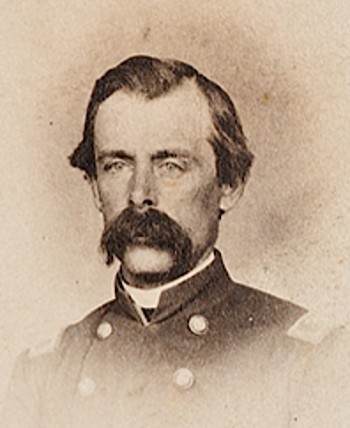
Hoyt went on to say that, “it will always be a censure by implication upon myself that I receive no recognition from my Government.” On May 23, 1865, Major General Q. A. Gillmore, his commanding officer, wrote a letter of commendation to him citing, “…my high appreciation of the administrative ability and correct judgment uniformly displayed by you since you have occupied the difficult position of post commander at Charleston. Your administration in all its details receives my unqualified approbation.” Gurney remained with the regiment until it mustered out on June 30, 1865, at Charleston, South Carolina.
Gurney remained in Charleston after the Civil War and was a wholesale grocer there until 1870 when he was elected treasurer of Charleston County, serving until 1876. In 1873 and 1874, he was a presidential elector and was appointed by President Ulysses S. Grant to serve on the Centennial Commission, and was elected its vice president. On January 24, 1885, members of his regiment received a charter for Grand Army of the Republic Post #538, named in his honor, located in Bay Shore, New York. At the time of his death from heart disease, he lived in New York City. Mary J. Gurney applied for and was granted a widow’s pension in 1879. Section 75, lot 12459.
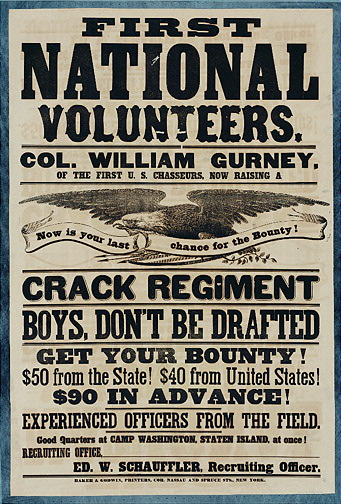
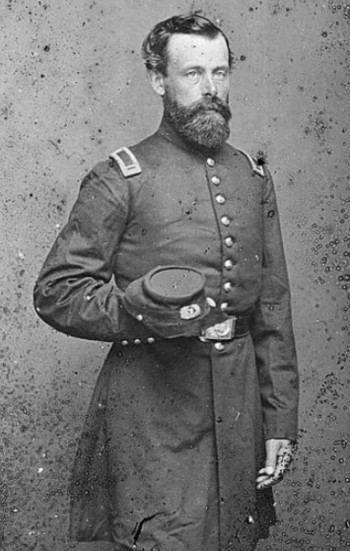
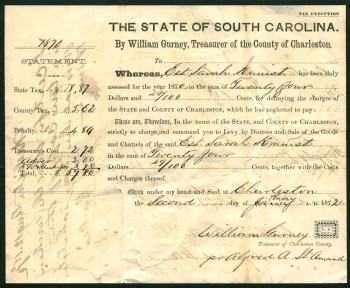

GUTHRIE, JOHN N. (1840-1894). Private, 5th New York Infantry, Company B; 146th New York Infantry, Company G; 2nd Battalion, Veteran Reserve Corps, 118th Company. Guthrie, who was born in New York City, was employed as a clerk when he entered service. He was 5′ 9″ with hazel eyes and light hair. After enlisting as a private at New York City on August 18, 1862, he immediately mustered into the 5th New York, and transferred into the 146th New York on May 4, 1863. He was listed as hospitalized on August 18, 1863, suffering from jaundice and diarrhea. Guthrie subsequently served in the 2nd Battalion of the Veteran Reserve Corps beginning in December 1863 until he mustered out on May 30, 1865.
Guthrie is listed as a tobacconist in the 1874 and 1883 Brooklyn Directories, is identified as a merchant in the 1880 census, and is listed as a presser in the 1884 Brooklyn Directory. As per his obituaries in the New York Tribune and the New York Herald, he was in the wholesale tobacco business with his brothers. Their firm, Guthrie & Co., was at 225 Front Street in Manhattan. A Freemason, he also belonged to the De Witt Clinton Commandery of the Knights Templar and the Eckford and Union Clubs; members of his Masonic chapters were invited to attend his funeral. His last address was 382 McDonough Street in Brooklyn. He died of blood poisoning following an abscess sustained after a fall. In 1895, his widow, Mary Guthrie, who is interred with him, applied for a widow’s pension, application 616,115, but there is no evidence that it was certified. Section 24, lot 6764, grave 10.
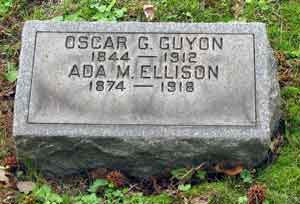
GUYON, OSCAR G. (1844-1912). Sergeant, 156th New York Infantry, Company I. A Staten Island native, Guyon enlisted at New York City as a private on November 12, 1862, and mustered into the 156th New York six days later. As per his muster roll, he was a “tinman” who was 5′ 9″ tall with blue eyes, brown hair and a light complexion. On December 31, 1863, he was promoted to corporal of his company and then to sergeant on April 10, 1864. He mustered out at Augusta, Georgia, on October 23, 1865.
In 1870, Guyon was living in New Dorp, Staten Island, and working as a tinsmith. In 1885, he applied for an invalid pension that was approved under certificate 969,635. In 1899, he became a resident at the Soldiers’ Home in Bath, New York. His records at the Soldiers’ Home indicate that he suffered from rheumatism and a right inguinal hernia as a result of his military service. On August 7, 1904, while a resident of the Soldiers’ Home, he mustered into the William F. Barry Post #248 of the G.A.R. Guyon died of a cerebral hemorrhage. Section 52, lot 4749, grave 2.
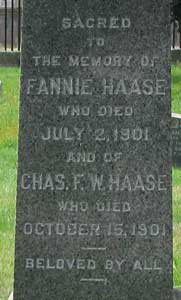
HAASE, CHARLES F. W. (1827-1901). Surgeon, 5th Regiment, New York State Militia. Haase, originally from Saxony, Germany, became a naturalized citizen on November 22, 1859. During the Civil War, he enlisted as a surgeon at New York City on April 19, 1861, was commissioned into the Field and Staff of the 5th Regiment, also known as the Jefferson Guard, on May 1, and mustered out after three months on August 7 at New York City. In 1863, when the 5th was part of the New York State National Guard, he re-enlisted as a surgeon on July 5, returned to the Field and Staff, and mustered out on July 22 after 30 days at New York City
In 1895, his application for an invalid pension was approved, certificate 909,691. His name is listed in the Directory of Deceased American Physicians, 1804-1929 as a practitioner of allopathic (mainstream) medicine. He last lived at 794 Lexington Avenue in Manhattan. His death was caused by an incised wound in the abdomen. Section 206, lot 30874, grave 1.
HAASE, CHARLES H. (1832-1862). First lieutenant, 11th Regiment, New York State National Guard, Company C. A German native, Haase enlisted as a first lieutenant at New York City on May 28, 1862, was immediately commissioned into Company C of the 11th Regiment, and mustered out on September 16, 1862, at New York City. As per his obituary in the New York Tribune, his comrades gathered at the Delancey Street Armory after his funeral, and his body was escorted to Green-Wood Cemetery where he was interred with full military honors. He last lived at 93 Delancey Street in New York City. His death was attributed to congestion of the lungs. Haase was originally buried at Green-Wood on November 26, 1862, in lot 8998, grave 439; his remains were removed from the cemetery on August 6, 1863.
HABIRSHAW, FREDERICK (1841-1889). Marine engineer. Habirshaw was born in New York. As per his obituary in the Brooklyn Daily Eagle, he was the son of William Habirshaw (see) and educated as a marine engineer. His occupation entailed taking monitors (iron-clad ships) to their stations along the Southern coast during the Civil War. After the War, Habirshaw entered the oil business after crude was discovered in Pennsylvania. He was connected with the Downe Oil Company, the only enterprise that was not taken over by Standard Oil. His main interest was the ocean carrying trade, especially the lines to Boston. Habirshaw retired from his business at 113 Maiden Lane in Manhattan in 1887, gave up his home at 385 Greene Avenue in Brooklyn, and went abroad with his wife.
Among his friends, Habirshaw was known as a gentleman and as a connoisseur of the arts and a man of culture. He is mentioned in a book about Artemus Ward, one of President Abraham Lincoln’s favorite authors: Artemus Ward (Charles Farrar Browne): A Biography and Bibliography (p. 173), by Don Carlos Seitz. Seitz identifies Habirshaw as an engineer who transported monitors to Hampton Roads, Virginia, during the Civil War. Habirshaw died in Paris, France, on September 27, 1889, where he spent the greater part of the last two years of his life. He had hoped to restore his health; his brother, John Habirshaw, a physician, was with him when he died. His death was attributed to cirrhosis. He was interred at Green-Wood on December 31, 1889, and moved to the current location on August 21, 1890. Section 28, lot 24365.
HABIRSHAW, WILLIAM M. (1810-1881). Third assistant engineer, United States Navy. Born in New York City at 197 Williams Street, he was a merchant. As per his obituary in the New York Herald, he was a clerk for an importer of woolens, traveled to London aboard the Westminster, arriving on December 11, 1838, became a member of a concern known as John Mortimer & Co. in 1840, then went to London again to establish a branch office of that firm. He retired from business in 1860.
During the Civil War, Habirshaw served in the Navy as a third assistant engineer beginning on July 29, 1861. His appointment was revoked on February 5, 1862. His son, Frederick (see) was a marine engineer who transported iron-clads to their stations in the South. His last residence was 6 West 48th Street in Manhattan, where according to the 1880 census, he was living with his wife, two sons (one a doctor), 91-year-old mother and two Irish servants. His death was attributed due to a “fatty heart.” Section 28, lot 9892.
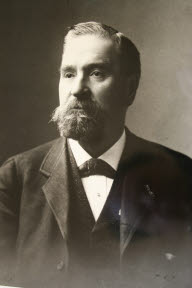
HADDOCK, WASHINGTON M. (1839-1904). Private, 7th Regiment, New York State Militia, Company B. . A New York City native, Haddock enlisted at New York City as a private in April 1861, and served for 30 days with the 7th Regiment. In 1862, when the 7th Regiment was part of the New York State National Guard, he returned to the same company for three months. Draft Registration Records from 1863 indicate that he was employed as a tobacconist. As per his passport application of 1872, he was 5′ 11½” tall with brown eyes, light brown hair, a high forehead, light complexion, round chin and straight nose. He was a member of Lafayette Post #140 of the G.A.R., the Military Club, and the 7th Veterans’ Association. The Veterans Schedule of 1890 verifies his Civil War service.
Haddock was in the tobacco business with his father at 11th and Hudson Street in Manhattan until 1894. After his father died in 1891, Haddock, who was one of the executors of the will, testified in 1900 that his father, William J. Haddock, left an estate worth $229,817.68, including numerous properties on Hudson Street, and property on Perry Street, Greenwich Street, West 11th Street, and Charles Street in Manhattan; six areas of land in Columbia County, New York, and 64 acres in the town of Ossining, New York, and other stocks and bonds. At the time of his testimony, he attested that he was the manager of the estate and that the properties had lost value.
The census of 1900 notes that he was retired. According to his obituary in The New York Times, he was the director of the North River Insurance Company at the time of his death. He died of a stroke while out for a walk in Central Park, a favorite pastime. Haddock was wearing two diamond rings, a valuable watch and carrying a large sum of cash when his body was found by a meat-wagon driver. Another obituary notes that a Seventh Regiment pin was on his person when he died. It was first assumed that he was struck by a car until he was examined by the coroner. He last lived in the San Remo Hotel on Central Park West in Manhattan. Section 69, lot 2004.
HADLEY, ANDREW JACKSON (1834-1911). Sergeant, 4th New York Cavalry, Company F. A Brooklynite by birth, he enlisted as a sergeant on October 3, 1861, mustered into the 4th New York Cavalry that same day, and was discharged for disability on October 13, 1864, from Augur General Hospital in Alexandria, Virginia. As per his obituary in the Brooklyn Daily Eagle, he fought at many major battles of the Civil War including Bull Run, Virginia, and Gettysburg, Pennsylvania. In one unspecified battle, his horse was shot from under him. In addition, he was one of the escorts to President Abraham Lincoln at the final review of the Grand Army of the Potomac. He served under Generals Siegel, Hooker, Burnside and McClellan.
In 1869, Hadley lived in Syracuse, New York, where his name was listed in that city’s directory as a carpenter; he was also listed as a carpenter in the 1871 Brooklyn Directory. In 1879, his application for an invalid pension was approved, certificate 234,980. According to the 1880 and 1890 censuses, he was living in Brooklyn and was employed as a carpenter. Hadley was a member of the George C. Strong Post #534 of the G.A.R. The Veterans Census of 1890 confirms his Civil War service. His obituary in the Brooklyn Daily Eagle, noted that members of his G.A.R. post and the Veteran Association of the 4th New York Cavalry were invited to his funeral. His obituary in the Brooklyn Standard Union, which also highlighted his Civil War service, stated that members of the George C. Strong Post planned to escort his remains to Green-Wood Cemetery. He relocated to New Jersey in 1908 where his last address was 816 Garden Street in Elizabeth, New Jersey. His widow, Mary Hadley, applied for a pension soon after his death caused by a cerebral hemorrhage in 1911; it was issued under certificate 724,194. Section 85, lot 5722.
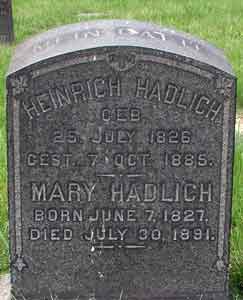
HADLICH (or HADLEY), HENRY (1826-1885). Bandleader, 93rd New York Infantry; private, 52nd New York Infantry, Company A. Originally from Bavaria, Germany, immigration records indicate that he arrived in the United States as “Heinrich Hattlich” in 1850 on the St. Denis. According to the 1860 census, he was working as a musician. After he enlisted on September 28, 1861, at New York City, he mustered into the 93rd that day as a bandleader. He mustered out on November 8 of that year at New York City as per a directive of Governor Edwin D. Morgan. He also served as a private in the 52nd New York.
According to the censuses of 1870 and 1880 and the 1872 Brooklyn Directory, he was employed as a musician. The Veterans Census of 1890 validates his Civil War service. His last address was 340 6th Street in New York City. He died of heart disease. Section 2, lot 5499.
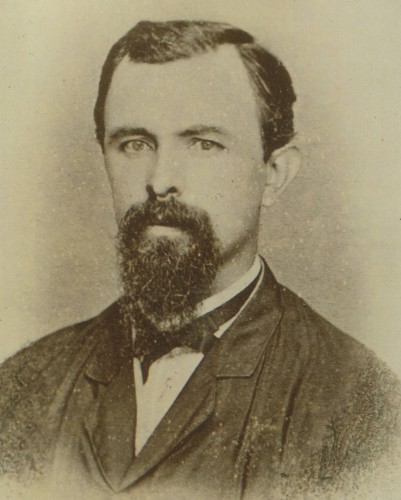
HAFF, ROBERT C. (1842-1917). Private, 23rd Regiment, New York State National Guard, Company A. Haff, who was born in New York State, served with the 23rd Regiment when it was activated for 30 days in 1863. He mustered out in September 1863. On March 1, 1865, he began employment as a clerk at the United States Treasury in New York City and continued working there for more than fifty years. On the 50th anniversary of his employment, Haff and another man, who also worked for half a century, were honored by all the employees at the Treasury and each was given a solid gold shirt set with diamonds set in the centers. In a speech honoring the two, a fellow employee toasted their service and said in part, “…I have never known either of you to break one rule of this office, and I have been deputized by your fellow clerks to present you with these handsome tokens of their esteem.” The Veterans Census of 1890 confirms his military service. His last residence was in Franklin Township, Hunterdon County, New Jersey. His death was attributed to pulmonary oedema. Section 185, lot 18252.
HAFNER, PHILIP (1826-1889). Chaplain, 45th New York Infantry; corporal, 5th Regiment, New York State Militia. Born in Hesse-Darmstadt, Germany, Hafner enlisted as a corporal on May 16, 1861, mustered immediately into the Field and Staff of the 5th New York State Militia, and mustered out at New York City on August 7. He re-enlisted as a chaplain on September 9, 1861, at New York City, and mustered into the Field and Staff of the 45th New York on November 4. He was discharged for disability on August 31, 1862.
The census of 1870 lists him as a tailor; the 1884 Brooklyn Directory indicates that he was a teacher. Hafner became a naturalized citizen in 1886. His last residence was at 113 Third Avenue in New York City. Section 142, lot 22137.
HAGAR, JOHN (1835-1907). Private, 23rd Regiment, New York State National Guard, Companies H and A. Born in Brooklyn, Hagar enlisted there as a private in 1863 and served with the 23rd Regiment when it was activated that year for 30 days. As per the Brooklyn Directory for 1864 and the 1880 census, he was a typefounder (designer and producer of metal printing type). He was a member of the Grand Army of the Republic, Winchester Post #197, and the 23rd Regiment Veteran Association; his comrades were invited to attend his funeral. His last residence was 128 West 112th Street, New York City. Cardiac dilatation was the cause of his death. Section 54, lot 4170.
HAGEDORN, JOHN M. (1838-1898). Captain, 131st New York Infantry, Company G; corporal, 71st Regiment, New York State National Guard, Company G. Hagedorn was born in New York City. After enlisting as a corporal at New York City on May 28, 1862, he mustered into the 71st Regiment, and mustered out at New York City on September 2. He re-enlisted at New York City on August 30, 1862, as a captain, was commissioned into the 131st a week later on September 6, and mustered out on March 2, 1864. He mustered into the John A. Dix Post #135 of the G.A.R. on April 13, 1881. A merchant in civilian life, he traveled to Genoa, Italy, in September 1896 aboard the Kaiser Wilhelm II carrying three bags of luggage as per the passenger manifest. He last resided at 5 West 22nd Street, New York City. He died comatose. Section 74, lot 6494, grave 5.
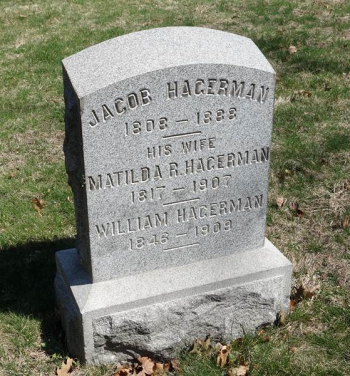
HAGERMAN, JACOB (1808-1888). Seaman, United States Navy. Hagerman, a native New Yorker and the father of William (see), enlisted as a seaman in the United States Navy at New York City in 1856. At that time, he was 5′ 4¾” tall with gray hair, blue eyes and a dark complexion. During the Civil War, he re-enlisted at New York City on June 18, 1861. On June 21, 1861, his application was stamped “rejected.” He last lived at 117 Prince Street in Brooklyn. Section 81, lot 3188.
HAGERMAN, WILLIAM (1846-1909). Private, 52nd Regiment, New York State National Guard, Company K; landsman, United States Navy. A sail-maker by trade, his father was Jacob Hagerman (see). William Hagerman was 5′ 4″ tall, of fair complexion with blue eyes and light hair, with the tattoo “K.D.” on his right arm. He first served with the 52nd Regiment from June 19, 1863, until he was discharged on July 25, 1863. He enlisted in the United States Navy on May 16, 1864, as a landsman, and served on the USS North Carolina. He also served on the USS Potomac, Cayuga, and Vermont. On January 12, 1865, while he was assigned to the Cayuga, he was admitted to the hospital suffering from enuresis, the inability to control urination. Hagerman’s hospital ticket listed his personal effects: one blanket, one bag, one flannel shirt, one set of drawers, one frock, one handkerchief, six pairs of pants, four over-shirts, three caps, one pair of stockings, and two pairs of shoes or boots. Discharged on August 24, 1865, he re-enlisted on February 2, 1867, in the 20th U.S. Infantry, Company K. He was discharged from this duty on February 2, 1870. He applied for and was awarded a pension from the Navy, certificate 13,242. His last Brooklyn residence was at 116 Beverly Road. As per his paperwork at the National Home for Disabled Soldiers in Hampton, Virginia, when he was admitted on November 25, 1908, he was an upholsterer by trade. He died there. Section 81, lot 3188.
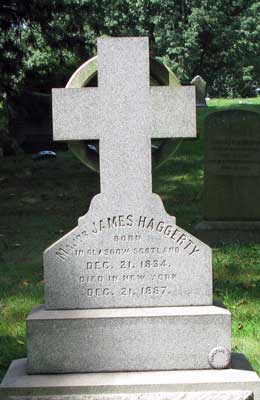
HAGGERTY, JAMES (1834-1887). First lieutenant and adjutant, 11th New York Infantry. Born in Glasgow, Scotland, and educated there, Haggerty became a lawyer after immigrating to the United States. During the Civil War, he enlisted as a first lieutenant at Centreville, Virginia, on January 28, 1863, and was commissioned that day as a first lieutenant and adjutant into the Field and Staff of the 111th New York Infantry. He was discharged for disability on June 1, 1863.
In 1869, he was appointed United States consul at Glasgow but the British government refused to grant him exequatur (permission to perform his legal duties) because of his ties to Ireland. He then served as deputy naval officer at the Port of New York for two years. A Republican until 1872, he changed parties to stump for Horace Greeley and his campaign for president. Subsequently, he served twice as a Congressman.
As per his obituary in The New York Times, an army hat and sword and the American flag adorned his casket. Other tributes were sent by the Jesse Reno Post #68 of the G.A.R. of which he was a member, the Manhattan Branch of the Irish National League of which he was president for seven years, and the Women’s Suffrage League whose ivy tribute was inscribed “Our Champion.” The obituary noted that Haggerty requested that the G.A.R. ritual be read at his funeral. Many dignitaries and elected officials attended the service. Although referred to as “major” in his obituary and on his tombstone, it is unclear how he received that honor. He last lived at 225 East 49th Street in Manhattan. As per an article in The New York Times on January 9, 1888, the Manhattan Branch of the Irish National League held a meeting to commemorate Haggerty’s ardor for Irish independence and vowed to rededicate their efforts until Ireland was free. Section 42, lot 10948.
HAGGERTY, ROBERT (1842-1878). Private, 10th New York Infantry, Company E. Born in New York State, he enlisted as a private at Plattsburg, New York, on August 24, 1864, and mustered into the 10th New York the same day. He served for the remainder of the conflict, mustering out on June 30, 1865, at Munson’s Hill, Virginia. As per the census of 1870, he was employed as a packer. After the Civil War, he moved to New York City and last resided at 85 Thompson Street in Manhattan. Section 17, lot 17245, grave 352.
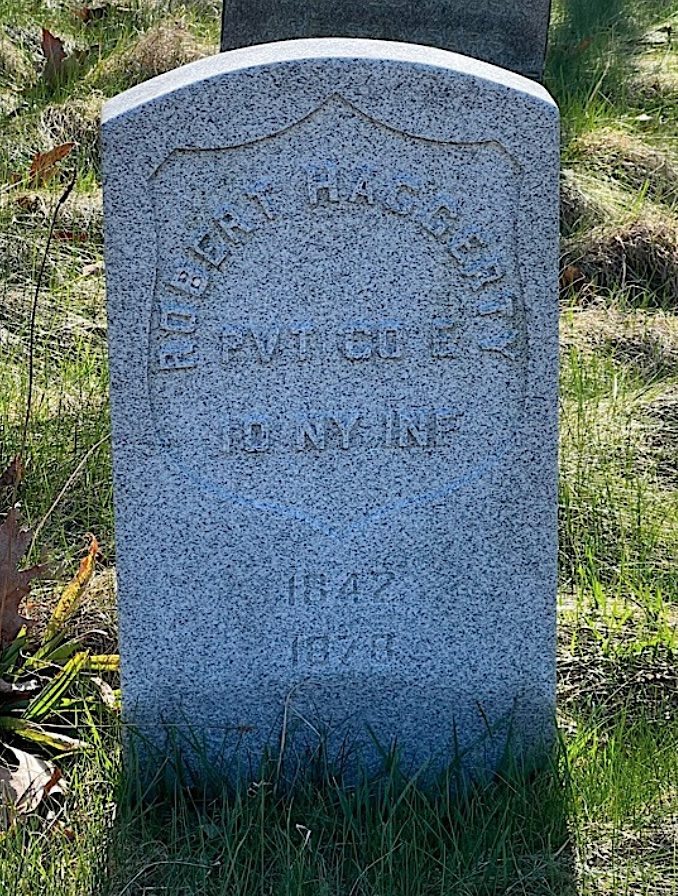
HAHN, HERMAN (or HERRMAN) (1837-1891). Corporal, 29th New York Infantry, Company C. Born in Germany, Hahn enlisted as a private at New York City on June 4, 1861, and mustered into the 29th New York that same day. He was promoted to corporal on November 30 and was discharged for disability on September 1, 1862, at Baltimore, Maryland.
Although he applied for a pension in 1876, application 228,403, there is no certificate number. As per the census of 1880, he was a merchant; the New York City Directory for 1888 lists him as a grocer. The Veterans Schedule of 1890 verifies his Civil War service. At the time of his death from apoplexy, he lived at 158 Sixth Avenue in Manhattan. In 1891, Emma Hahn, who is interred with him, applied for and was granted a widow’s pension, certificate 356,918. Originally interred in lot 18513, his remains were moved to current site on May 23, 1896. Section 143, lot 29114.

HAIGHT, EBURN (or ELRIM, EDWIN, ELWIN) FOWLER (1844-1920). Private, 80th New York Infantry, Company E. Born in Ellenville, New York, Haight enlisted as a private on September 25, 1861, at Wawarsing, New York. He mustered the same day into the 80th New York and was discharged for disability on July 8, 1862. He also served in the 20th New York State Militia, Company E.
According to the census records of 1900, he was a builder. In 1905, he applied for and received an invalid pension, certificate 1,116,160. At the time of the 1920 census, he was a retired building contractor. As per his obituary in the Brooklyn Standard Union, which verified his Civil War service, Haight was a Freemason, a trustee of the Lee Avenue Congregational Church for twenty-five years, and a member of the Hanover Club. He last lived at 594 Third Avenue, Brooklyn. He died from heart disease. His widow applied for and received a pension in 1920, certificate 906,384. Section 166, lot 27131.
HAIGHT, TUNIS (or TUENIS) B. (1817-1864). Private, 11th New Jersey Infantry, Company K. A native of New Jersey, he was employed as a shipwright in 1850 according to that year’s New York City Directory. By 1860, he moved back to New Jersey where he was a clerk. Haight enlisted on August 13, 1862, and mustered immediately into the 11th New Jersey. On September 25, 1864, he died of disease at Fort Schuyler Hospital in Throgs Neck, New York. He last lived at 13 Colden Street in Jersey City, New Jersey, as per that city’s directory. On October 24, 1864, Mary Haight, applied for and was granted a widow’s pension, certificate 103,218. Section 66, lot 3668.
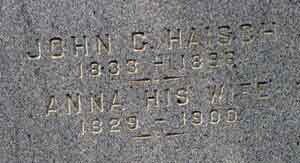
HAISCH, JOHN GEORGE (1833-1898). Private, 15th Regiment, New York Heavy Artillery, Company L. Born in Wurttemberg, Germany, Haisch enlisted as a private and mustered into the 15th Heavy Artillery on December 3, 1863. As per his muster roll, he was a tailor by trade who was 5′ 8″ tall with blue eyes, brown hair and a light complexion. He was discharged in the field for disability on July 20, 1864. His application for an invalid pension was granted in 1889, certificate 589,583. His last residence was 72 Charlton Street, Manhattan where his death was attributed to nephritis. Anna Haisch applied for and received a widow’s pension, certificate 465,253. Section 128, lot 32584.
HALE, ANTHONY (1841-?). Private, 10th Heavy Artillery, United States Colored Troops (USCT), Company A. Hale served in the 10th Louisiana USCT. The muster roll shows that he enlisted on November 16, 1862, at New Orleans, Louisiana, for a period of three years, and appeared on the rolls on November 29, the date he mustered in. All privates in the USCT were African-American. His name is displayed on the African American Civil War Memorial in Washington, D.C., plaque A-22. Section ?, lot ?.
HALE, DAVID WARD (1807-1884). Acting assistant paymaster, United States Navy. Hale, who was born in Portland, Maine, was living in Brooklyn in 1850 where he was employed as a merchant. He began his service in the Navy as an acting assistant paymaster on May 24, 1862. He resigned on March 3 the next year, but returned to service in September 1863 at the same rank, and mustered out on November 17, 1865. As per his pension application at age 62, he was 5′ 5″ tall with blue eyes, grayish brown hair and a light complexion. He noted that at Johnsonville, Tennessee, on or about November 4, 1864, while his gunboat, the Tawah, was under attack in the Tennessee River, he jumped into the waters and waded forty feet to shore. He then walked a mile to the rear of the Union’s forces in wet clothing all the while exposed to enemy fire. It was nighttime before he could dry off near the campfire and as a result of exposure contracted a disease that placed him in the care of his wife and family until May 1865. Subsequently, the disease caused permanent damage to his eyesight.
In 1870, Hale resided in Hackensack, New Jersey, was employed as a banker and had real estate holdings that totaled $6,000. The 1880 census showed him living in Westfield, New Jersey, where he earned a living as an insurance agent. In 1880, he applied for and received a pension from the Navy under certificate 6,826. In 1884, Hale petitioned the Pension Bureau for a new attorney after his original attorney moved away from Westfield, New Jersey, where Hale resided, in the middle of his pension request. He was living in Westfield at the time of his death attributed to “senile gangrene.” His wife’s request for a widow’s pension was turned down. Section 29, lot 11323.
HALE, JR., LUTHER E. (1841-1888). First lieutenant, 57th New York Infantry, Company D. Born in Connecticut, he enlisted as a first lieutenant at New York City on September 13, 1861, was commissioned into the 57th New York on November 12, and was discharged by Special Order No. 16, Paragraph 10, three months later on January 16, 1862. In 1870, he was living in Jersey City, New Jersey, and employed as a compositor with personal assets of $200. By 1874, he was living in Brooklyn and according to the Brooklyn Directory was employed as a reporter in 1875 and then listed “printer” as his occupation in 1876.
As per his obituary in the Yonkers Statesman, he lived in Yonkers at one time where in partnership with another resident, published a weekly called The Independent. That obituary noted that he was the night foreman at the Sun composing room for many years. His last residence was 561 Carlton Avenue in Brooklyn. Caroline M. Hale, who is interred with him, applied for and received a widow’s pension in 1891, certificate 334,849. He was interred at the present location in Green-Wood on May 4, 1899. Section 137, lot 26591.

HALE, WILLIAM D. (1832-1912). Rank unknown, 55th Massachusetts Infantry. Hale enlisted and served in an unknown company of the 55th Massachusetts. There are no further details. A member of the Grand Army of the Republic, Lafayette Post #140, from October 1905 to 1912, he last lived in New Jersey. A cerebral embolism took his life. Section 142, lot 24537, grave 4.
HALEY, JEREMIAH (1839-1919). Private, 79th New York Infantry, Company E. Haley enlisted as a private at New York City on May 13, 1861, and mustered into the 79th on May 28. After being wounded and taken as a prisoner of war at the First Battle of Bull Run, Virginia, on July 21, 1861, he was paroled on or about July 23. On May 24, 1862, he mustered out at Washington, D.C. According to the 1880 census, he was employed as a brass finisher. His application for an invalid pension was granted in 1890, certificate 755,979. He last lived on East 156th Street in the Bronx. Mary D. Haley, received a widow’s pension upon his death from chronic nephritis in 1919, certificate 878,435. Section A, lot 8100, grave 462.
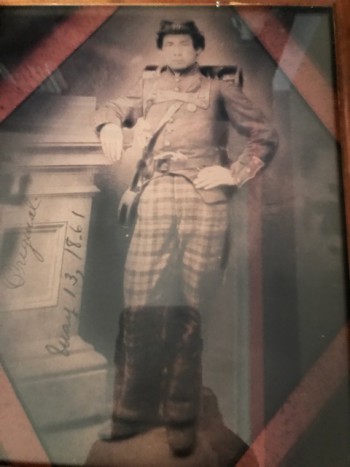
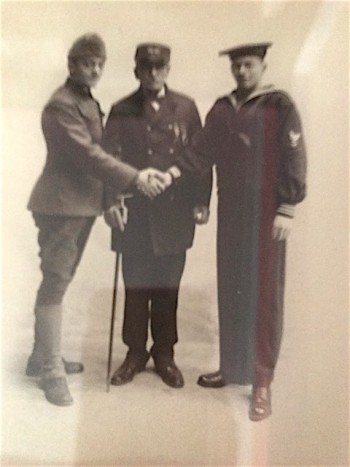

HALL, GEORGE B. (1825-1864). Colonel, 71st New York Infantry. Son of the first mayor of Brooklyn and brother of Matthew (see), George B. Hall served in the Mexican War as a lieutenant with the 1st New York, and fought at Vera Cruz, Churubusco, and Contreras. Among the first to volunteer from New York, he fought under General Winfred Scott and was recognized for his gallantry. On June 3, 1848, Hall’s father wrote to Secretary of War William I. Marcy asking for the revocation “for a short period” of an order that his son join his regiment in Mexico because his mother was suddenly very ill. The plea, made without Hall’s knowledge, appealed to the secretary of war as a father and man of family. It is unclear if the order was changed in any way. According to his obituary in the Brooklyn Daily Eagle, Hall, along with other “brave but mistaken men,” joined William Walker when he traveled to Nicaragua in the 1850s as part of a filibustering expedition, an unauthorized military outing into a foreign county to foment a revolution for financial gain or adventure. The obituary stated that Hall’s health suffered as a result of that journey.
However, Hall was ready to serve during the Civil War. In 1861, he enlisted on April 25 at New York City and was named colonel of the 71st New York Infantry, known as the Jackson Light Infantry, and was instrumental in organizing the Excelsior Brigade. Hall commanded the 2nd Brigade, 2nd Division of the 3rd Corps of the Army of the Potomac from September to December 1862. He was with his unit in every skirmish and battle they faced, from Stafford Courthouse to Fredericksburg, Virginia, and the Peninsula. Suffering from chronic hepatitis, Colonel Hall was discharged for disability on April 28, 1863. After returning home, he maintained his connection to the military, had an interest in the New York State National Guard, and commanded the 93rd Regiment. He also worked in the office of the city inspector. He died at his father’s home in Brooklyn on May 24, 1864, of “general debility,” and was buried with full military honors. Section 68, lot 3942.
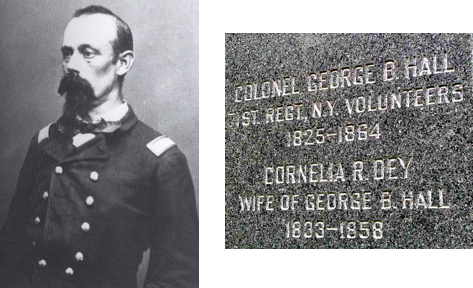

HALL, GEORGE F. (1838-1862). Assistant paymaster, United States Navy. Hall, a native of New York City, served as an assistant paymaster in the United States Navy as of June 11, 1862, in the Eastern Gulf Blockading Squadron. As per his obituary in the New York Herald, which confirms his Civil War service in the United States Navy, Hall died of yellow fever at Key West Florida, on September 1, 1862; Green-Wood records also confirm his death from yellow fever at Key West but note his date of death as September 5; his tombstone is inscribed with the September 1 date. His remains arrived on the steamer Union and were interred at Green-Wood on December 17, 1863–more than a year after his death. His parents, who resided in New York City, survived him. Section 101, lot 2013.
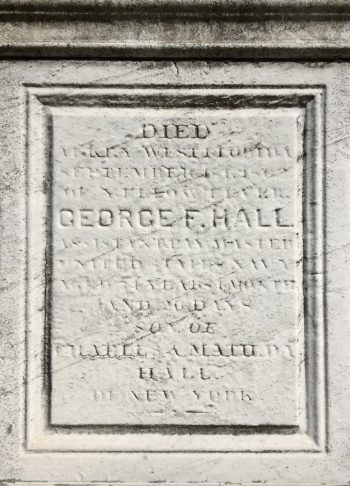
HALL, JR., ISAAC WATTS (1847-1923). Corporal, 127th New York Infantry, Company C. A native of New York City, the 1860 census reports that Hall was living in the 13th Ward of New York City with his parents and four siblings. A clerk at the time of his enrollment, Hall was 5′ 6″ tall with grey eyes, brown hair and a light complexion. After enlisting as a private on August 19, 1862, he mustered into the 127th New York on September 8, was promoted to corporal on March 2, 1864, and remained with the regiment until it mustered out on June 30, 1865, at Charleston, South Carolina.
At the time of the census of 1870, Hall was living in New York City with his wife and two young children and working as an expressman; the census of 1880 lists him as married with three children, living in New York City and working as a shipping clerk. In 1889, his application for an invalid pension was granted, certificate 464,914. He was living in Hoboken, New Jersey, in 1890 when his Civil War service was confirmed by the Veterans Census. The census of 1900 states that he was living in New York City and working as a janitor; the census of 1910 notes that he was a night watchman at a railroad yard, lived on 93rd Street in Manhattan, was able to read and write, and had been married for twenty-three years. Hall’s obituary in the Putnam County (New York) Courier confirmed his Civil War service. He last lived at 336 East 94th Street in Manhattan. His death was caused by cancer. Mary A. Hall applied for and received a widow’s pension in 1923, certificate 943,166. Section 113, lot 17600.
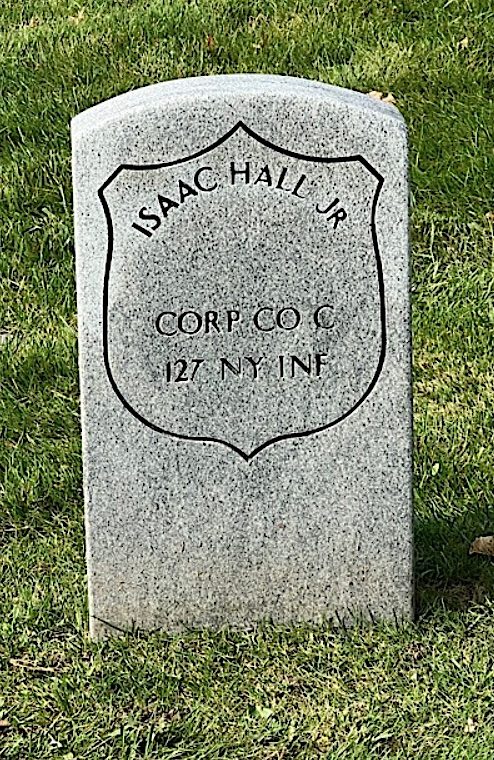
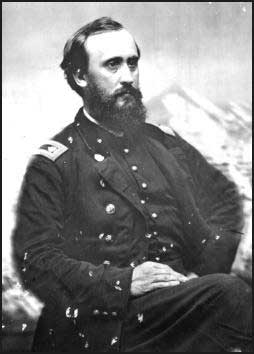
HALL, JAMES FREDERICK (1823-1884). Brigadier general by brevet; colonel, 1st New York Engineers. Originally interred at Green-Wood, his remains were removed in 1893. Although the cemetery records indicate that he was born in England, other accounts state that he was born in New York City. Hall enlisted at Albany, New York, on July 27, 1861, and was commissioned into the Field and Staff of the 1st New York Engineers as its major on October 10, 1861. On February 14, 1862, he was promoted to lieutenant colonel of 1st Engineers and became its colonel on February 16, 1865. On February 24, 1865, he was promoted by brevet to brigadier general. As per his obituary, he was attached to the Army of the Potomac towards the end of the Civil War and took part in the campaign that culminated in General Robert E. Lee’s surrender at Appomattox Courthouse, Virginia. Hall was discharged on June 30, 1865, at Richmond, Virginia.
In July 1871, Hall was appointed assistant United States appraiser and held that position for the rest of his life. In addition, he belonged to the Dahlgren Post #113 of the G.A.R. His obituary noted that the staff of the Appraiser’s Office at 402 Greenwich Street in Manhattan passed resolutions honoring his memory. Hall’s last residence was in Tarrytown, New York. He died from Bright’s disease.
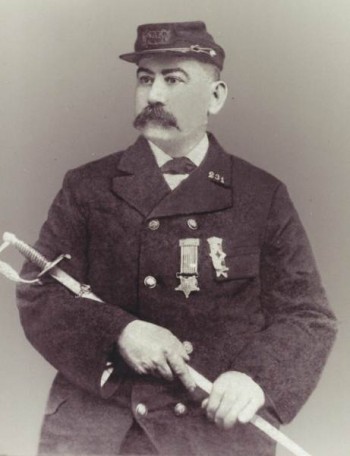
HALL, JAMES PATTON (1843-1908). Private, 47th New York Infantry, Company K. Born in New York City, Hall was 5′ 6″ tall, with brown eyes, dark hair and dark complexion, and was an iron railing finisher by trade. He enlisted at New York City on July 5, 1861, as a private. On September 14, he mustered into Company K of the 47th New York, also known as the Washington Grays. On February 16, 1863, he suffered a hernia unloading shells from the steamer Ocean Empress and was taken to General Hospital in Hilton Head, South Carolina. He was discharged for disability on May 9, 1863, at Hilton Head.
After the Civil War, Hall worked as a watchman. He applied for and received an invalid pension in 1872, certificate 117,691. He was a member of Cushing Post # 231, G.A.R., the 47th Regiment Veterans Volunteer Association, Cushing W.R.C. No. 136, and the Lincoln Council No. 16, N.P.U. As per his obituary in the Brooklyn Daily Eagle, members of those organizations were invited to his funeral. He last lived at 483 Fourth Avenue, Brooklyn. He died from nephritis. Julia A. Hall, who is interred with him, applied for and received a widow’s pension, certificate 640,195. Section 85, lot 5281, grave 5.
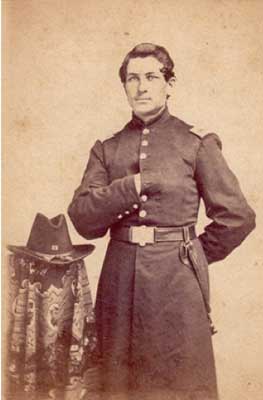
HALL, JAMES W. (1836-1912). First lieutenant, Massachusetts Unattached Infantry, 9th Company; second lieutenant, 53rd Massachusetts Infantry, Company C; sergeant major, 1st Massachusetts Infantry, Company B. A native of Boston, Massachusetts, and a caulker by trade, Hall enlisted at East Boston as a sergeant major on May 23, 1861, and mustered into the Field and Staff of the 1st Massachusetts Infantry two days later. On August 9, 1862, he was reduced in rank to private and transferred to Company B. Subsequently, he was commissioned as a second lieutenant on November 5, 1862, effective upon his transfer to Company C of the 53rd Massachusetts on November 18. He mustered out on September 2, 1863, at Camp Stephens in Groton, Massachusetts.
Returning to service, Hal was promoted to first lieutenant on April 28, 1864, and commissioned into the 9th Company of the Massachusetts Unattached Infantry where he served for 90 days in 1864. (Unattached companies were assigned to guard the defenses of the Massachusetts coast.) He mustered out on August 11, 1864. Hall was a member of the Grand Army of the Republic, Abraham Lincoln Post #11 in Charlestown, Massachusetts. In 1892, his application for an invalid pension was approved under certificate 863,680. His last residence was 408 13th Street in Brooklyn. Hall succumbed to Bright’s disease. Section 115, lot 19729, grave 34.
HALL, JOHN (1839-1932). Captain, 4th New York Cavalry, Company L; 9th New York Cavalry, Company L. Of English birth, he enlisted at New York City as a first lieutenant on January 28, 1863, and was commissioned into the 4th New York Cavalry on that date. He was promoted to captain on February 15, 1864. His leg was amputated as a result of wounds suffered at Trevillian Station, Virginia, on June 11, 1864. Hall was transferred into the 9th New York Cavalry on February 27, 1865, and mustered out on August 24, 1865, at Buffalo, New York. On December 2, 1865, his application for an invalid pension was granted under certificate 56,801. His last residence was 108-40 New York Avenue in Jamaica, Queens, where he died of myocarditis at age 92. His wife applied for and received a widow’s pension, certificate 182,092. Section 135, lot 27263, grave 210.

HALL, MATTHEW (1828-1884). First lieutenant, 71st New York Infantry, Company D. First lieutenant, 71st New York Infantry, Company D. A New York native, Hall was the son of the first mayor of Brooklyn, George Hall, and the brother of Colonel George B. Hall (see). As per the 1850 census, he was a clerk; the 1860 census reports that he was a painter. After enlisting on May 1, 1861, at Staten Island, he was commissioned into the 71st New York as a first lieutenant on June 21, and served until his discharge on January 19, 1863.
According to his obituary in the Brooklyn Daily Eagle, members of the Veteran Association of the 23rd Regiment’s National Guard and the Society of Old Brooklynites were invited to attend his funeral. The Brooklyn Standard Union reported that members sent a letter of condolence to Hall’s bereaved family. That obituary also reported that Hall was an honorary member of Company D of the 23rd Regiment. His funeral was at St. Ann’s Church where he served as an usher. At the time of his death from pneumonia, he resided at 108 Gates Avenue in Brooklyn. Section 68, lot 3942.

HALL, SAMUEL (?-?).Musician, 4th United States Army, Company H. It is likely that he is the Samuel Hall who served as a musician in the 4th United States Army. Born in New York, he was 18 when he enlisted. At that time, he was 5’¼” tall with auburn hair and brown eyes. Regimental records indicate that he was first in Company H, deserted on February 4, 1865, returned on May 5, 1866, and was discharged as a musician on March 5, 1868, at the expiration of service. His tombstone indicates that he was a musician in the War. Section 128, lot 31394, grave 415.

HALL, THOMAS J. (1832-1878). Private, 155th New York Infantry, Company G. Born in Springfield, Massachusetts, and a machinist by trade, Hall was 5′ 8″ tall with blue eyes, brown hair and a fair complexion. After enlisting at Poughkeepsie, New York, on January 19, 1865, he mustered immediately into the 155th. He was discharged on June 15, 1865, at Munson’s Hill, Virginia, as per General Order No. 77 of the War Department. His service is confirmed by the Town Clerks’ Registers of Men Who Served in the Civil War in the New York State Archives. He last lived in Manhattan at 8 West 33rd Street. His death was attributed to an “overdose.” Section 57, lot 2341.
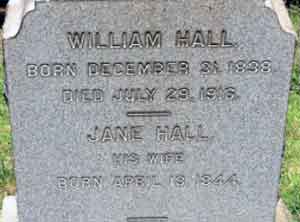
HALL, WILLIAM (1838-1916). Private, 17th United States Infantry, Company B; 51st New York Infantry, Company H. Private, 17th United States Army, Company B; 51st New York Infantry, Company H. Originally from Ireland and a bookbinder by trade, he was 5′ 6″ tall with gray eyes, brown hair and a fair complexion. Hall first served in the 17th Infantry, United States Regular Army. Further details about Hall’s service in the 17th are not specified. He re-enlisted on July 22, 1864, mustered into the 51st New York, and was discharged for disability at Fairfax Seminary, Virginia, on April 11, 1865. In 1896, his application for an invalid pension was approved under certificate 928,376. The cause of his death was pneumonia. In 1917, Jane Hall, who is interred with him, applied for and received a widow’s pension, certificate 827,357. Section J, lot 34546.
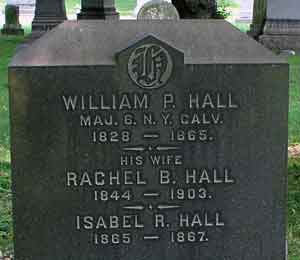
HALL, WILLIAM P. (or T.) (1828-1865). Major, 6th New York Cavalry, Company H. A New Yorker by birth, he enlisted as a captain at New York City on October 25, 1861, and was commissioned into Company H of the 6th New York Cavalry three days later. Hall was promoted to major on October 5, 1862, and was transferred to the Field and Staff on that day. Brigadier General Henry N. Naglee, United States Army, commended him in his field report from Yorktown, Virginia, on December 16, 1862, noting, “…he charged and ran five times his number of the King and Queen Cavalry through their encampment. His command marched over 90 miles, and performed their duties to my entire satisfaction.” After he led the assault at Pamunkey River on January 8, 1863, Major General Erasmus D. Keyes, United States Army, wrote from Yorktown, Virginia, on January 10, that Hall, “…left Yorktown on the evening of the 7th instant in steamers cooperating with the strong naval forces of this station…His success was complete, and he lost neither man nor horse…” Hall commanded the 6th in the following Virginia skirmishes: White House on May 7, 1863; Warwick River on June 5, 1863; Baltimore Cross Roads on July 1, 1863; and Frederick Hall Station on February 29, 1864.
Captured in action in Kingston, Virginia, Hall was taken as a prisoner of war on June 7, 1864, and held at Libby Prison near Richmond, Virginia. On June 22, he was imprisoned at Macon, Georgia, where his health began to decline due to exposure and privation. He was moved again, as Sherman advanced through Georgia, to Columbia, South Carolina, where he was on the list of sick and convalescent. He was finally moved to Charleston, South Carolina, where he suffered a pulmonary hemorrhage and was paroled on December 10. He was granted a 60 day furlough and returned to New York City for medical treatment. On January 11, 1865, he became a lieutenant colonel, but never rejoined his regiment, instead being sent at the expiration of his furlough to convalescent camp at Annapolis, Maryland, where he remained until he mustered out on May 15 of that year.
As per his widow’s pension application, his physician in New York claimed that in May of 1865, Hall was “…greatly emaciated, very weak, unable to walk without assistance, had a troublesome cough and no appetite.” Another written statement from a regimental captain states that Hall was in sound health when he arrived at Macon, Georgia, but at the time of his lung hemorrhage, “…he was scarcely able to move about and suffered extremely from the exposure and severe treatment at Columbia, so that when parolled (sic), he was evidently in settled decline….” He died at home of bronchitis on October 20, 1865. He last lived at 101 West 36th Street, New York City. His widow, Rachel Hall, received a pension in 1866, certificate 97,719. In 1890, Rachel Hall, citing acts of Congress in 1884 through 1890, petitioned that her husband be re-mustered in at the rank of lieutenant colonel as of January 11, 1865, so that she could have her pension re-graded to reflect his higher rank. Section 189, lot 18270.
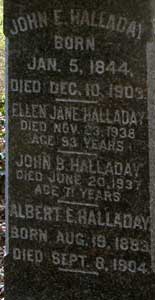
HALLADAY (or HALLIDAY), JOHN E. (or R.) (1844-1903). Drummer, 12th New York Infantry, Companies F and A, or private, 24th Connecticut Infantry. Company B. There are two men of the same name and age who might be the soldier buried at Green-Wood. With no pension record available for either veteran, it is not possible to make a definitive conclusion about the soldier history of the man in this lot. He may be the John Halladay who after enlisting as a drummer at Buffalo, New York, on November 20, 1861, mustered into Company F of the 12th New York nine days later. He was transferred intra-regimentally to Company A on August 30, 1862, and returned to Company F on April 27, 1863, from which he was discharged; or, he might be the John Halladay who was born in Connecticut and resided in Essex, Connecticut. That man enlisted as a private on August 30, 1862, mustered into 24th Connecticut on November 18, and mustered out with his regiment on September 30, 1863, at Middletown, Connecticut. As per the census of 1900, he was living in Jersey City, New Jersey.
In civilian life, the John Halladay interred at Green-Wood was a prosperous contractor and manufacturer of water pipes. That man was a Republican who organized the Lafayette Republican Association, served two terms on the Hudson Board of Freeholders and was a police commissioner in Jersey City. In addition, he was a Freemason. At the time of his death, he lived at 37 Dunbar Avenue in Jersey City, New Jersey. Section 19, lot 4115.

HALLECK, HENRY WAGER (1815-1872). General-in-chief of all Union Armies. Halleck was born in Westernville in Oneida County, New York, but ran away from his family’s farm to get an education. After he graduated Phi Beta Kappa from Union College, he was 3rd in the class of 31 in 1839 at the United States Military Academy. On July 1, 1839, he was appointed second lieutenant, Corps of Engineers, and was an assistant professor of engineering at West Point from July 6, 1839, through June 28, 1840. Halleck then served as an engineer at Fort Wood, Bedloe’s Island, and at Governor’s Island, New York Harbor, until 1846. He also traveled to France to learn about European fortifications and later translated Henri Jomini’s biography of Napoleon. He has been described as a brilliant officer of great intellect (his nickname was “Old Brains”) but also as an unsuccessful general because of his excessive caution and aloofness. His book, Elements of Military Arts and Sciences which was published in 1846, later became the authoritative manual for officers during the Civil War.
He served in California as an engineer during the Mexican War, was the secretary of state of the territory, and was a central figure in its transition from a territory to a state, writing much of its new constitution. After resigning his commission in 1854, he remained in California to study law. He married Elizabeth Hamilton, granddaughter of Alexander Hamilton, in 1855. During his time as a civilian, he wrote numerous works on mining and international law and was awarded a law degree from Union College in 1862.

When the Civil War broke out, Halleck was the head of the most prominent law firm in San Francisco. He volunteered for service, was appointed major general with rank from August 1861, and given command of the Department of Missouri, replacing John C. Fremont. He had great administrative abilities, but a poor grasp of field tactics. His brusque personality earned him more enemies than friends; President Abraham Lincoln said, “I am Halleck’s friend because he has no others.” Abolitionists loathed him for his order, while commanding the Department of the Mississippi, barring fugitive slaves from Union-held territories. According to Jack D. Welsh, M.D., in Medical Histories of Union Generals (1996, p. 145), Halleck was sick in January 1862 in St. Louis, Missouri, with camp measles. (Welsh also notes that Halleck suffered annually every August from “hay-cold” which affected his eyes so badly that he could scarcely see well enough to write.)
After his success in taking Corinth, Mississippi (though he allowed Beauregard’s forces to escape), Halleck was summoned to Washington, and in July of 1862, he was given command as general-in-chief of all United States armies. Despite his administrative and organizational abilities, his inability to get along with his subordinates and superiors made him a poor choice for that position. General George B. McClellan called Halleck, “the most hopelessly stupid of all men in high position.” President Lincoln described Halleck as “little more than a first-rate clerk.” In June 1863, Halleck disagreed with General Hooker’s strategy of abandoning Harpers Ferry (now West Virginia), a move that ultimately led to Hooker’s resignation and his being replaced by General Meade. He did not do well in this position; typically, he urged Meade after Gettysburg to postpone further engagement with Lee. When General Grant triumphed at Vicksburg, Mississippi, and Chattanooga, Tennessee, Grant was made lieutenant general, and given overall command. Halleck remained in Washington until the end of the War as chief of staff of the army, making sure that Northern armies were properly equipped, fed and reinforced. After the War, he was given command of the Division of the South in 1869. This was his last command; he died of brain congestion on January 9, 1872, in the arms of his brother-in-law Schuyler Hamilton (see). He last resided in Louisville, Kentucky. Section 185, lot 20293.
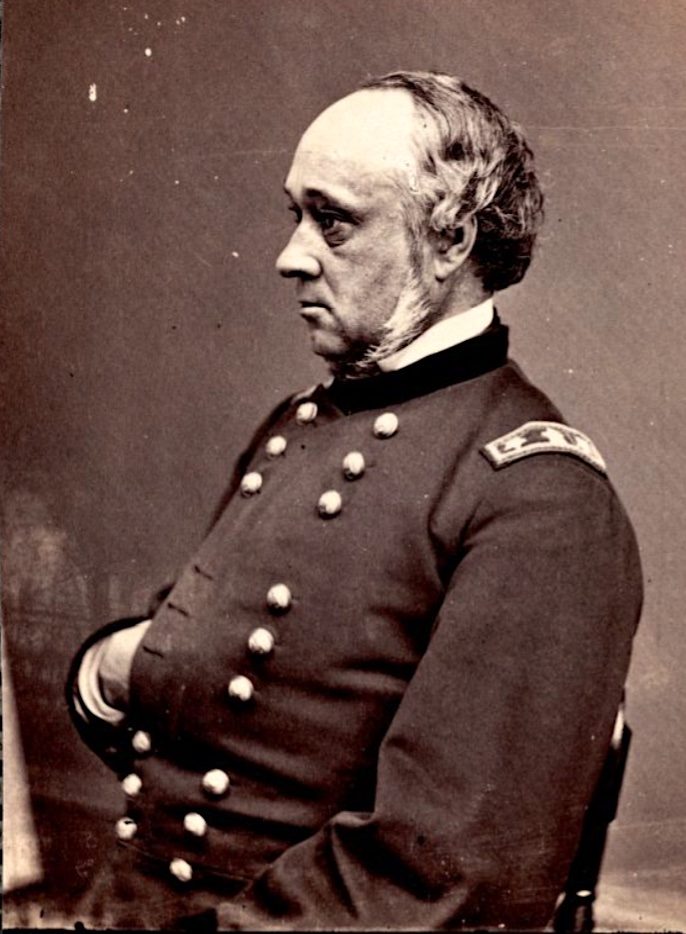
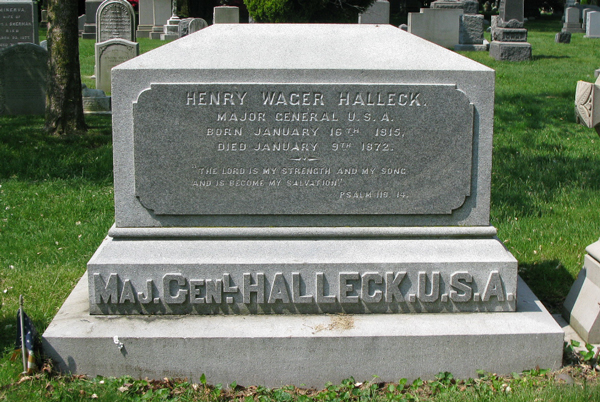
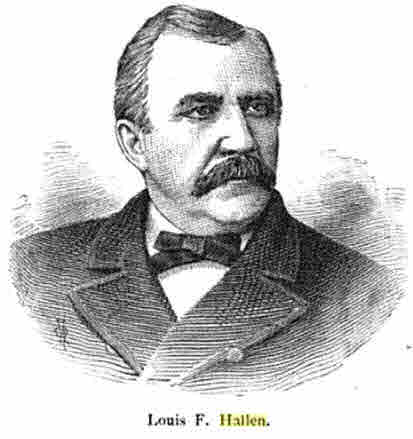
HALLEN, LOUIS (or LEWIS) F. (1831-1898). Unknown rank, 5th New York Infantry. A native of Sweden, he immigrated to the United States at age eighteen. In the 1850s, he was a member of Engine Company No. 34 of the Old Fire Department where he was considered brave and hard-working. According to his obituaries in New York newspapers, he served in the 5th New York in the Civil War, was promoted for gallant conduct and then was an officer in the United States Army after the War.
His New York Military Service Card indicates that he was a major in the 5th Regiment as of February 28, 1871, and a captain in the 14th Regiment in 1875. He belonged to numerous organizations including the Old Volunteer Fire Department of which he was the treasurer, the Army and Navy Club, the Harlem Society, the Old Guard, Odd Fellows, and the Swedish Society. A well-to-do merchant, Hallen last lived at 1861 Madison Avenue in Manhattan. He died from acute nephritis. He was related by marriage to David and William H. Van Cott (see) who are buried in the same lot as him. Section G, lot 18611.
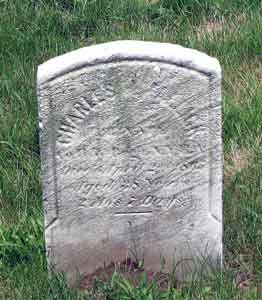
HALLICK, CHARLES H. (1827-1865). Private, 5th New York Heavy Artillery, Company H. Hallick enlisted as a private at Brooklyn on January 11, 1864, and mustered into the 5th Heavy Artillery the same day. On October 19, 1864, he was taken prisoner of war at the Battle of Cedar Creek, Virginia, and was paroled on an unknown date. He died from typhoid fever while on furlough on April 2, 1865, at New York City, where he lived on 6th Street. Section 117, lot 10975.
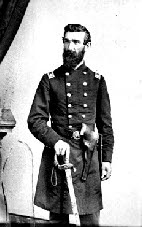
HALLICK (or HALLECK), WILLIAM H. (1822-1862). Lieutenant colonel, 9th New York State Militia/83rd New York Infantry. Hallick was a cabinetmaker and chair manufacturer at 468 Broadway in New York City, his birthplace, at the time of his enlistment. After enlisting at New York City as lieutenant colonel of the 9th, he mustered into its Field and Staff on May 27, 1861. He was commissioned lieutenant colonel of the 9th on May 30. When the 9th was not ordered into action under the first call for troops, its men organized as the 83rd and mustered into service on June 8, 1861, at Washington, D.C. On January 6, 1862, he died of disease at New York City. The muster roll incorrectly wrote the date of death as January 5, 1863, but later made the correction and marked it “accepted” after receiving formal certification of his death. John Wesley Jaques in his book, Three Years Campaign of the 9th N.Y.S.M. During the Southern Rebellion, wrote this tribute after the camp received news of his death:
Tuesday, 7th-…News was received in camp that our beloved Lieutenant Colonel, William Halleck, who was home on leave of absence, died of consumption, while surrounded by his family; often in Camp Smith, while everything was quiet, could be heard his coughing, whilst others slept, and the night that we left that camp, expecting to cross into Virginia, he commanded the regiment in the absence of the Colonel, and the next day when Companies A, D, and L were ordered to cross over to Harrison’s Island [as s prelude to the Battle of Big Bethel], he was eager to command them, but Brigadier General Stone, knowing it would be certain destruction to do so, countermanded the order. Lieutenant Colonel Halleck wished to to lay his life down for his country, and was willing to die on the field of battle. The officers met and passed resolutions of sympathy and condolence, which were sent to the bereaved family of their respected Lieutenant Colonel.
Matthew King, who on census records was listed as head of the household in which Hallick was counted, was appointed guardian for a minor’s pension awarded on February 28, 1863, for Hallick’s service. Section 40, lot 3938.